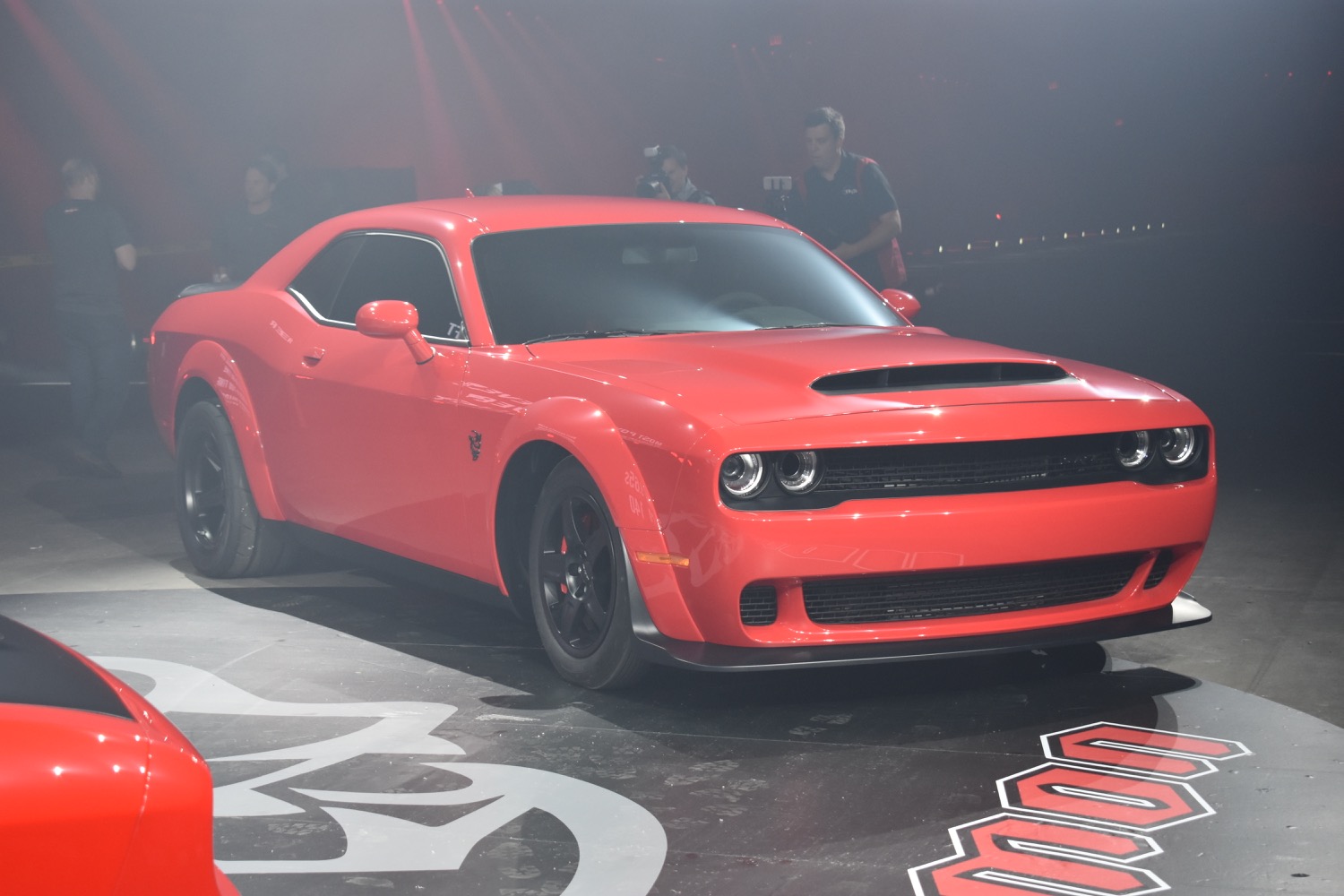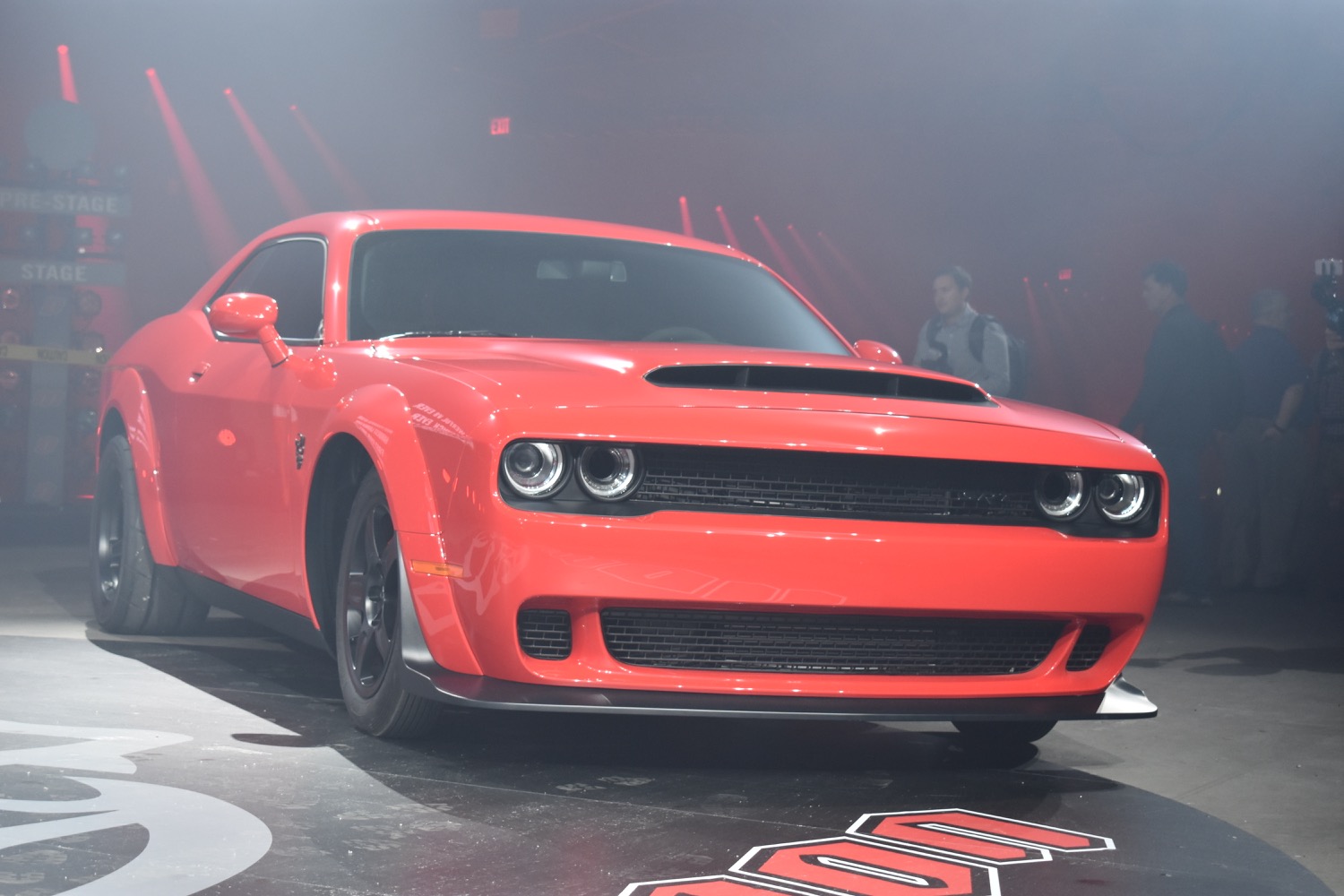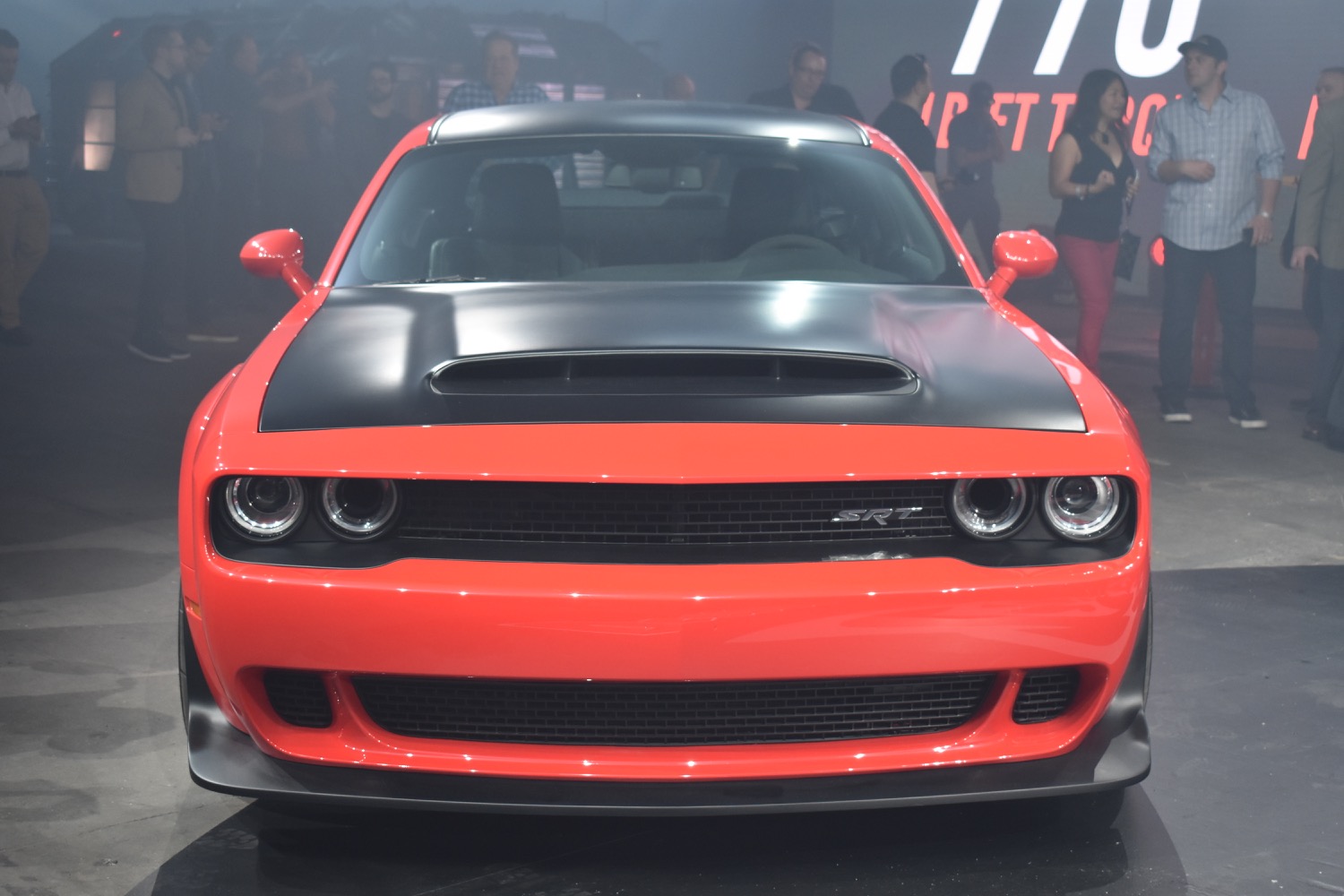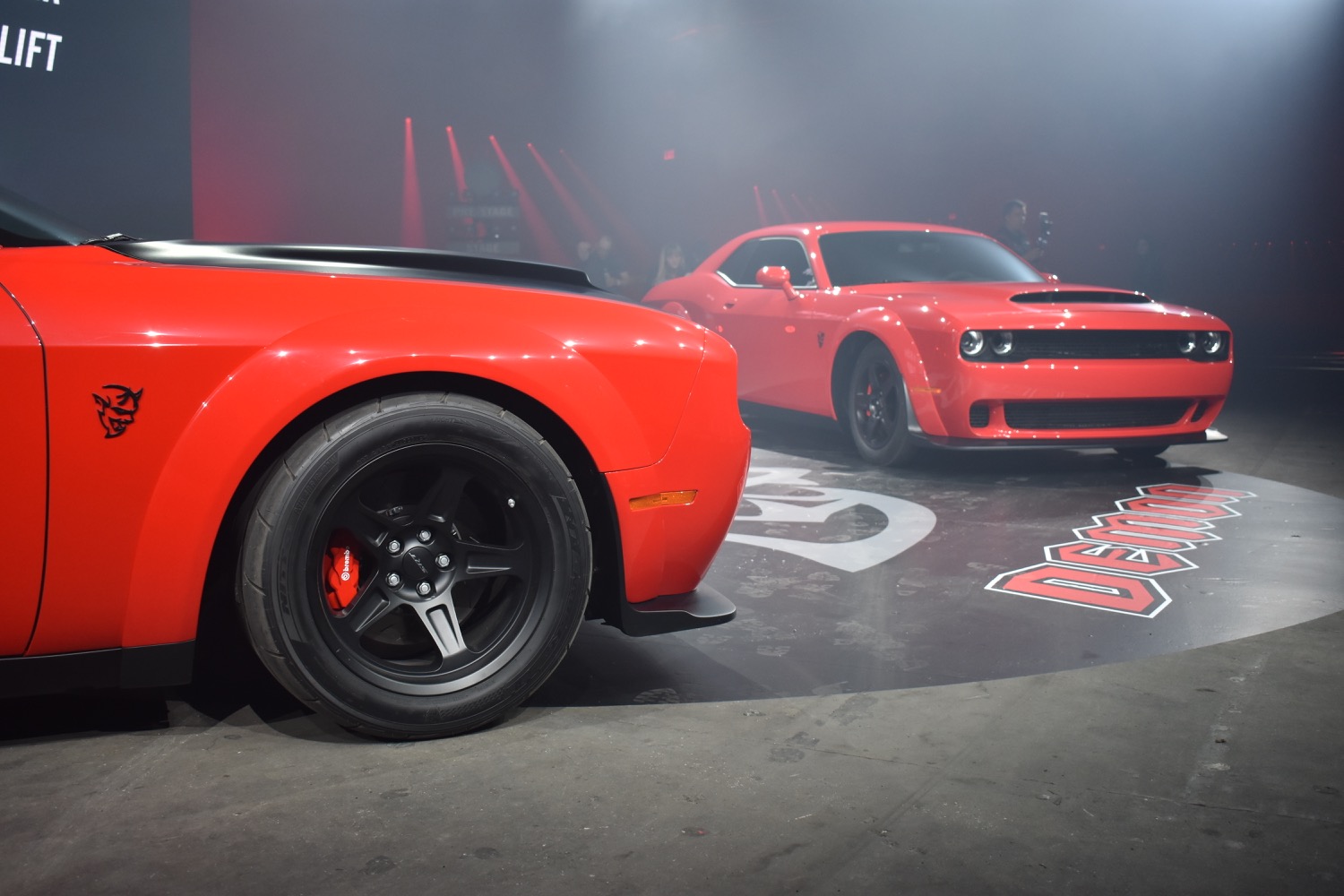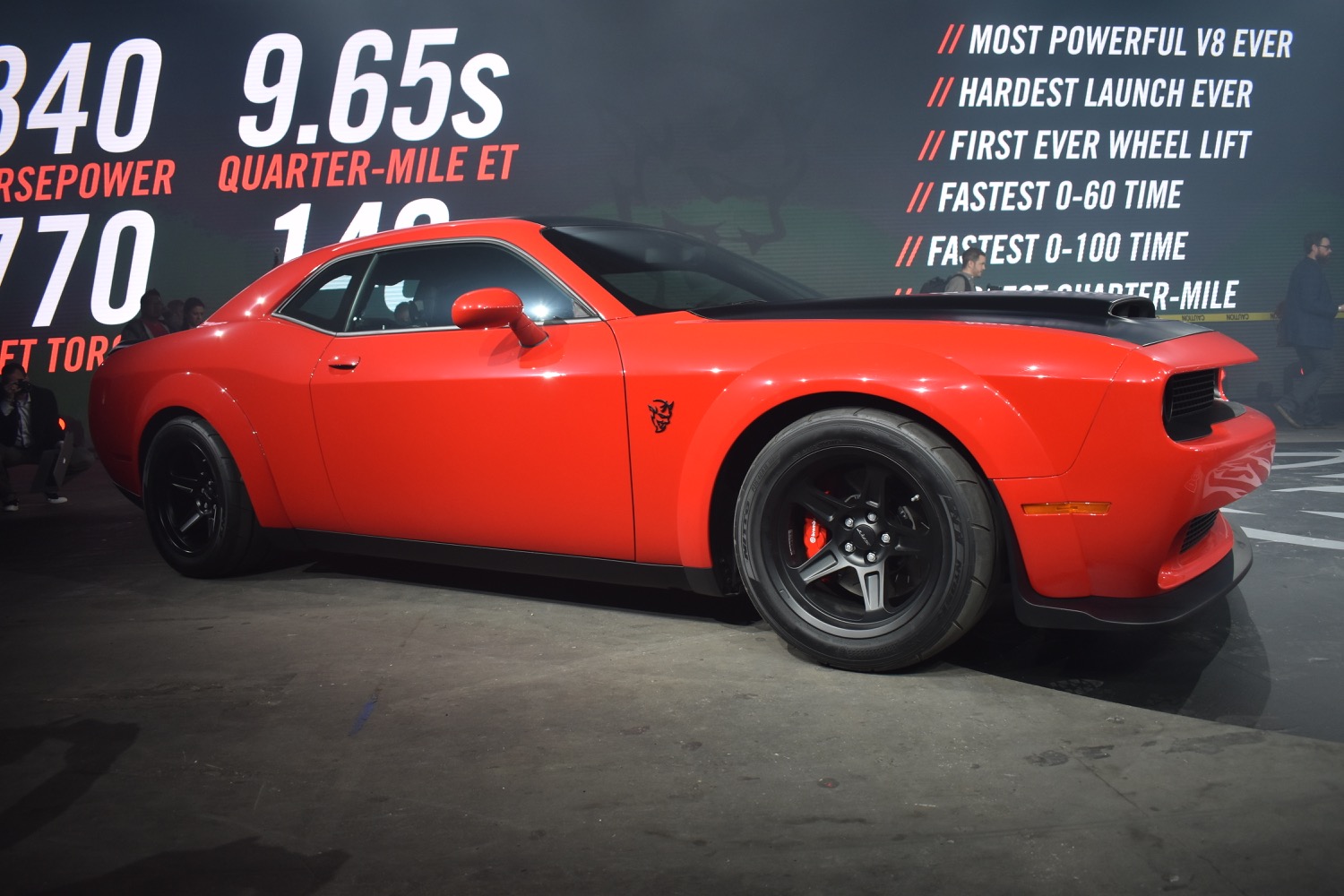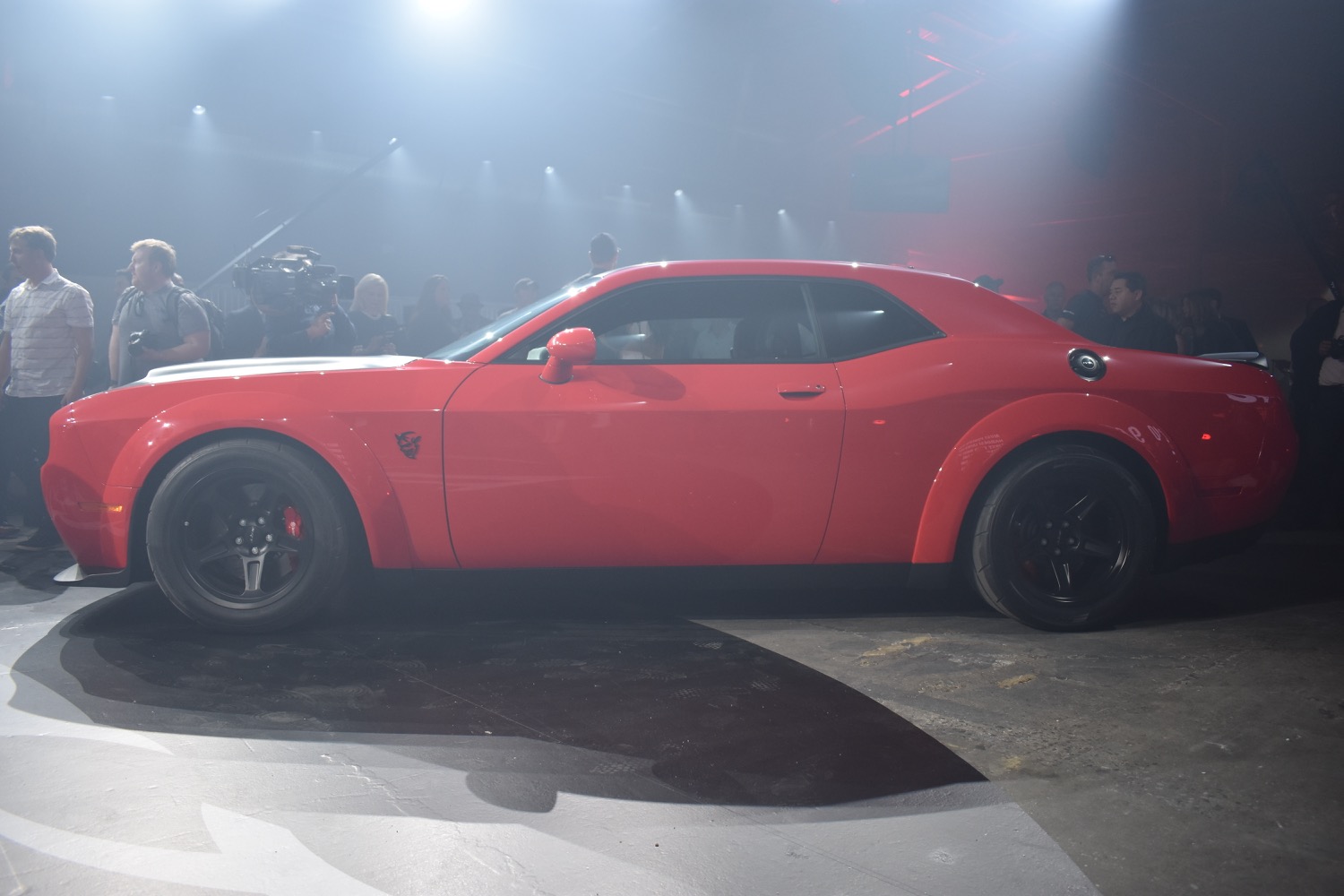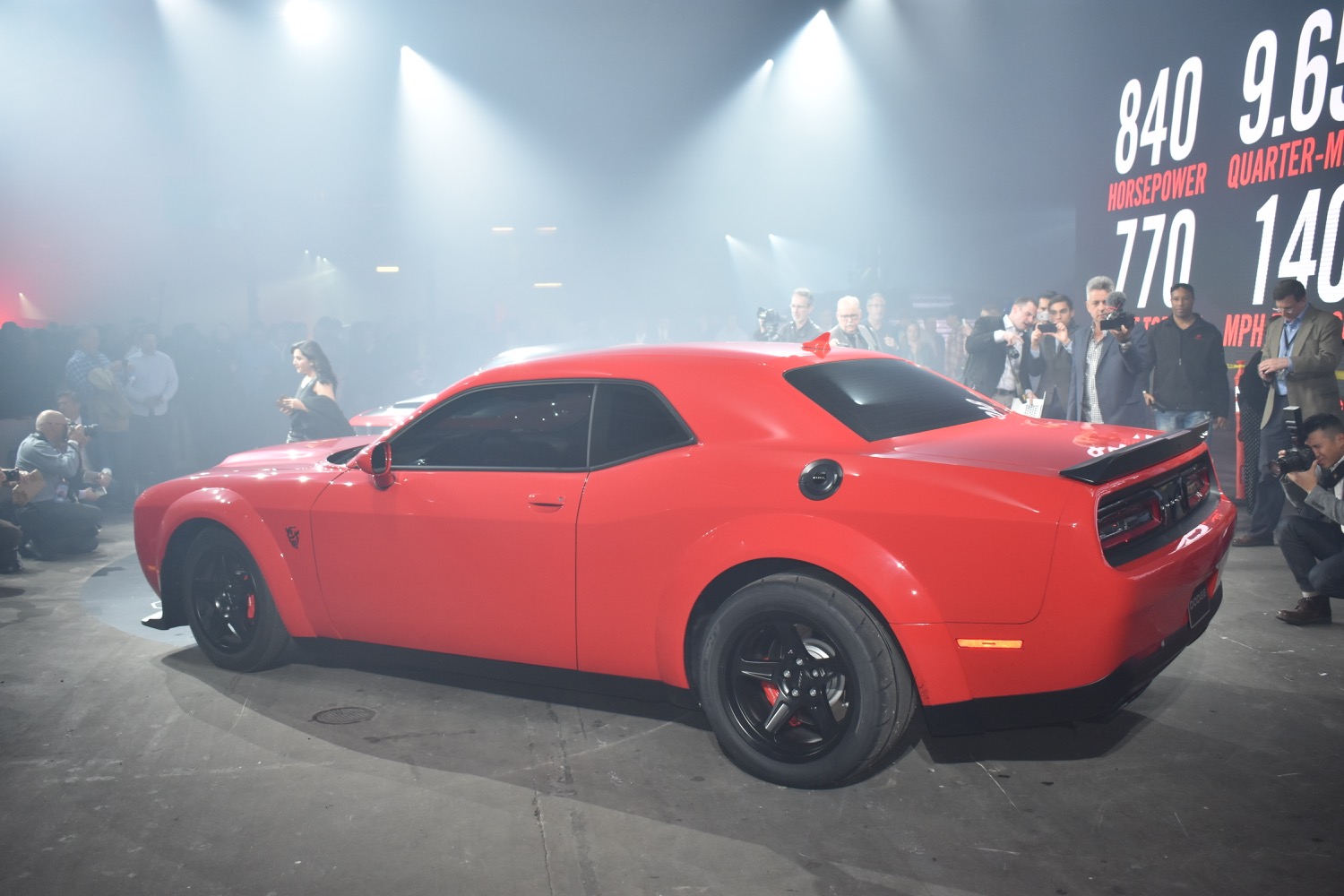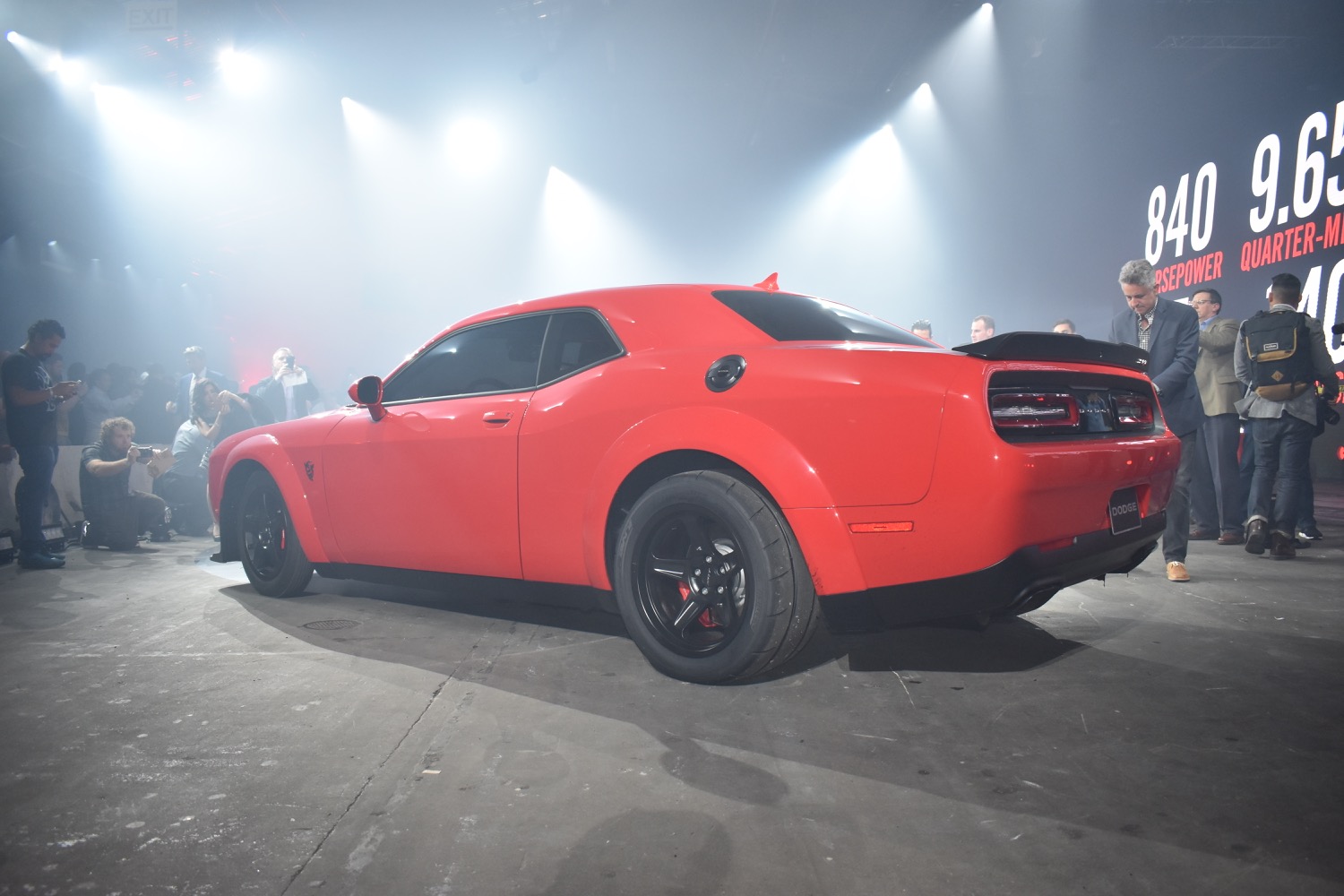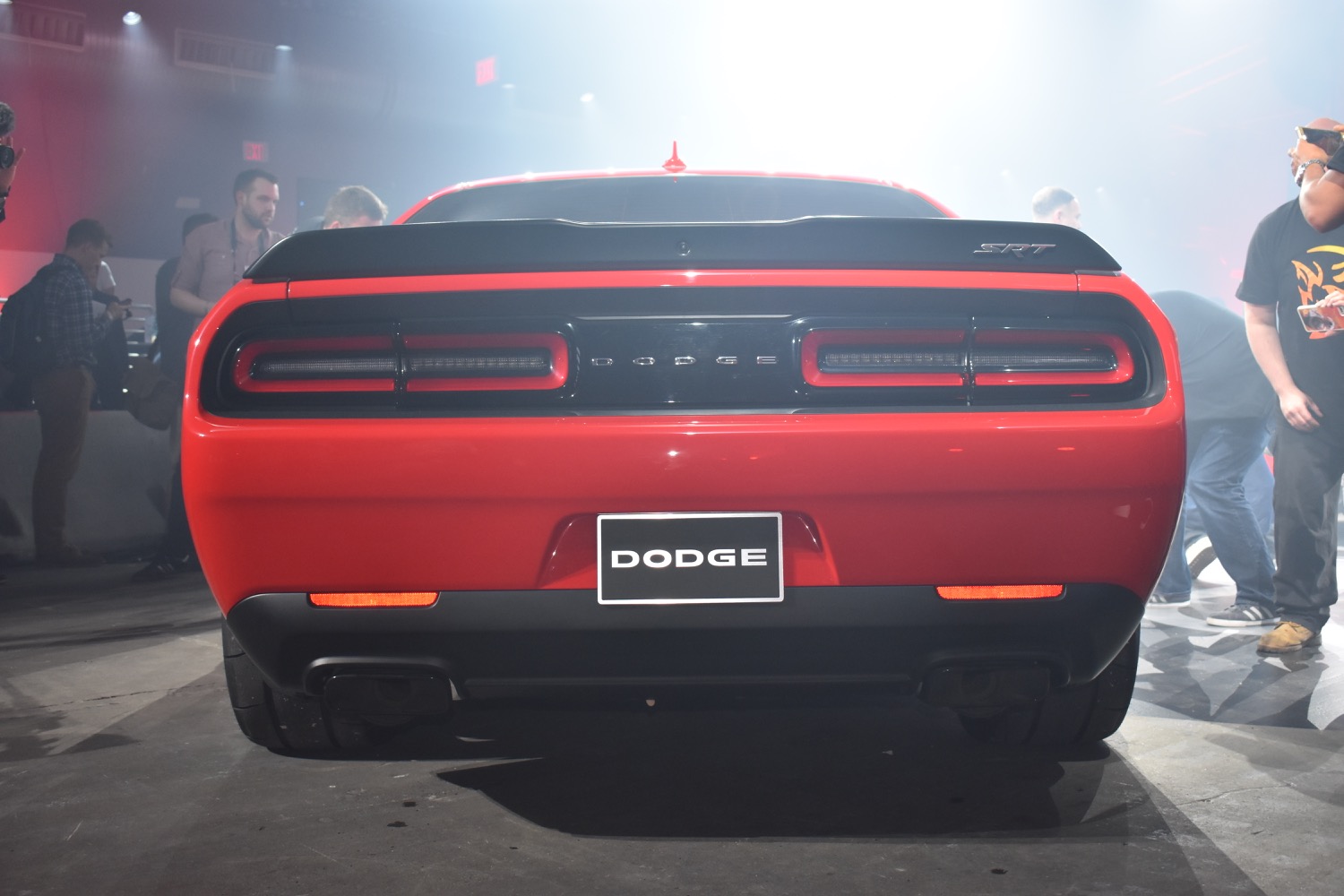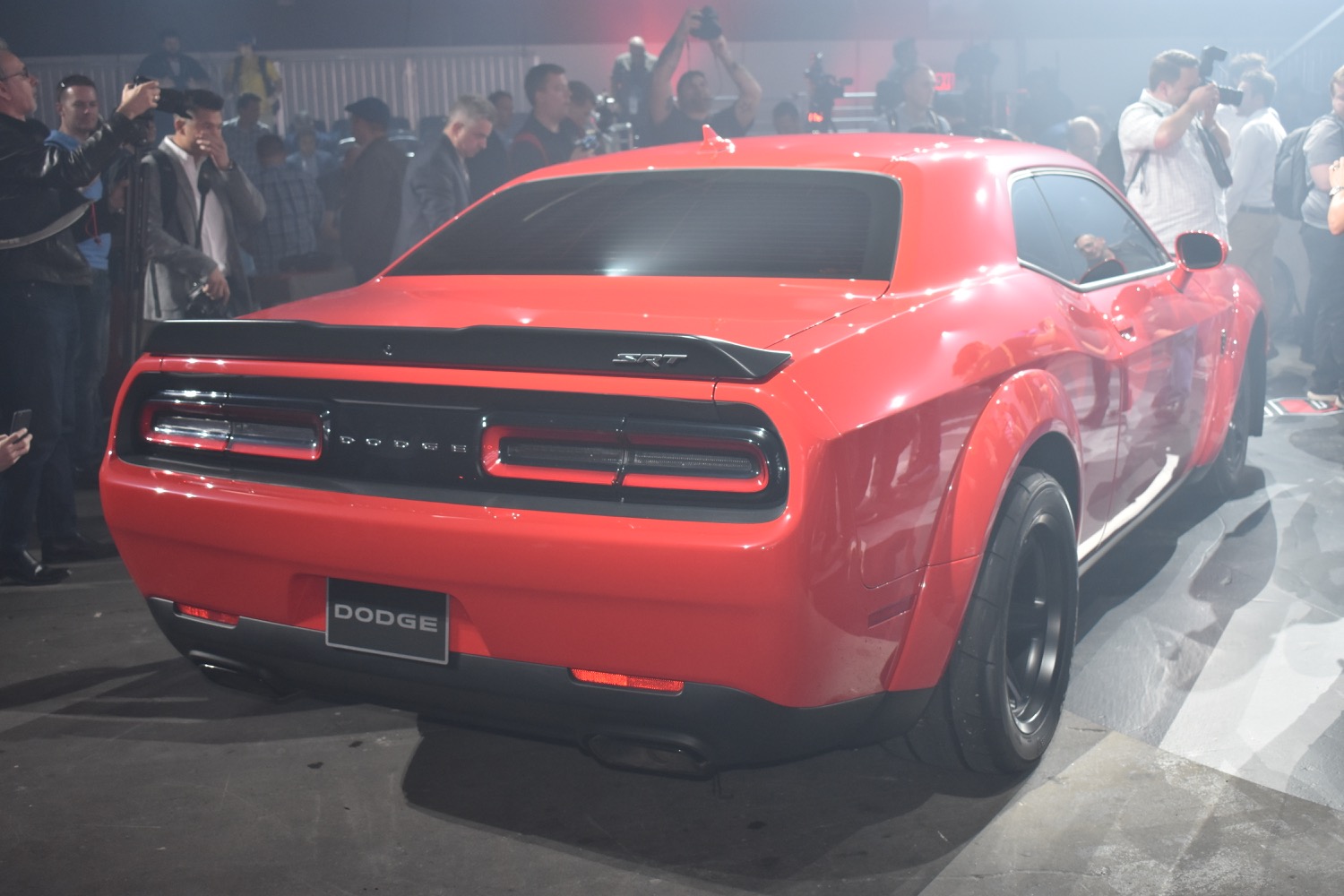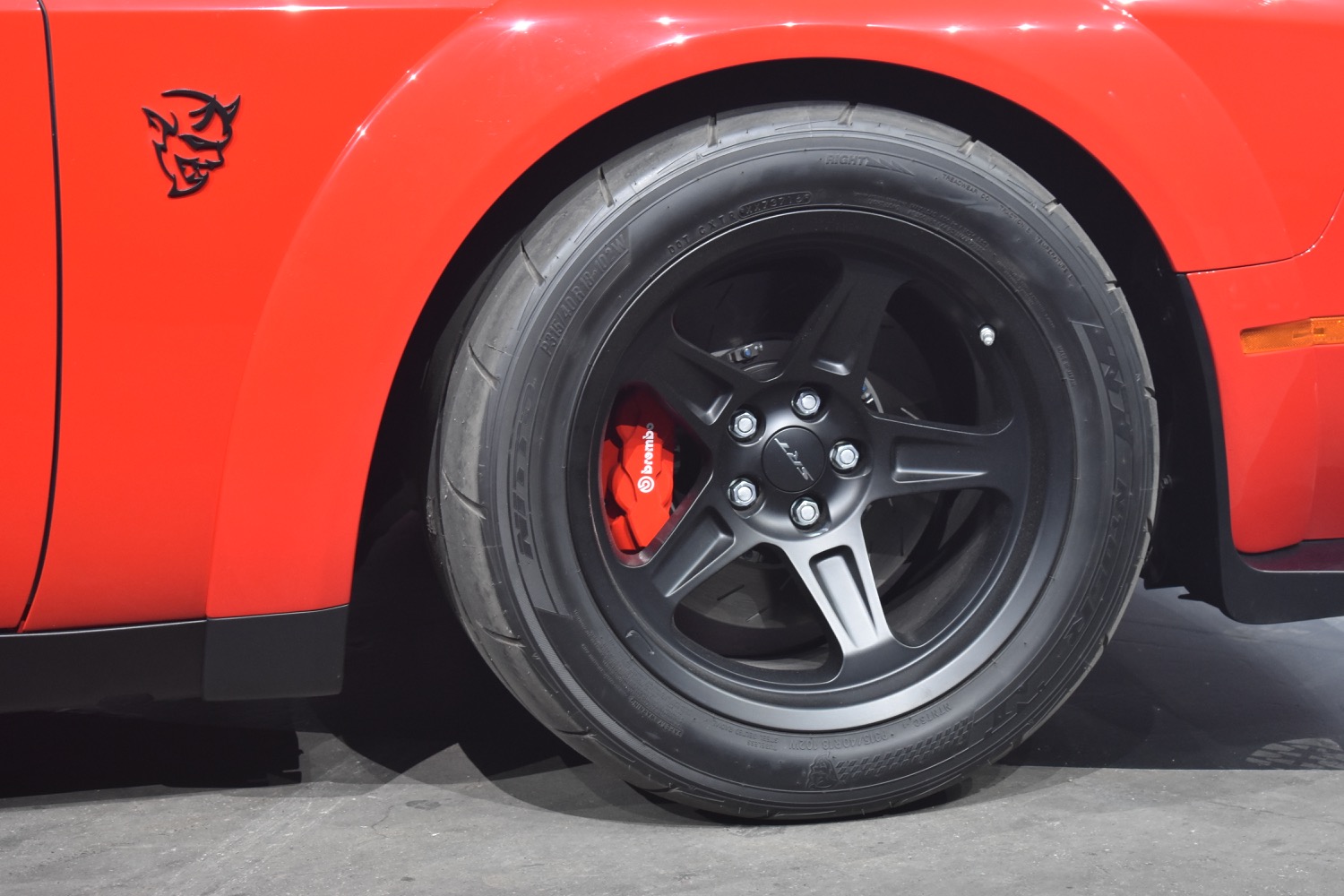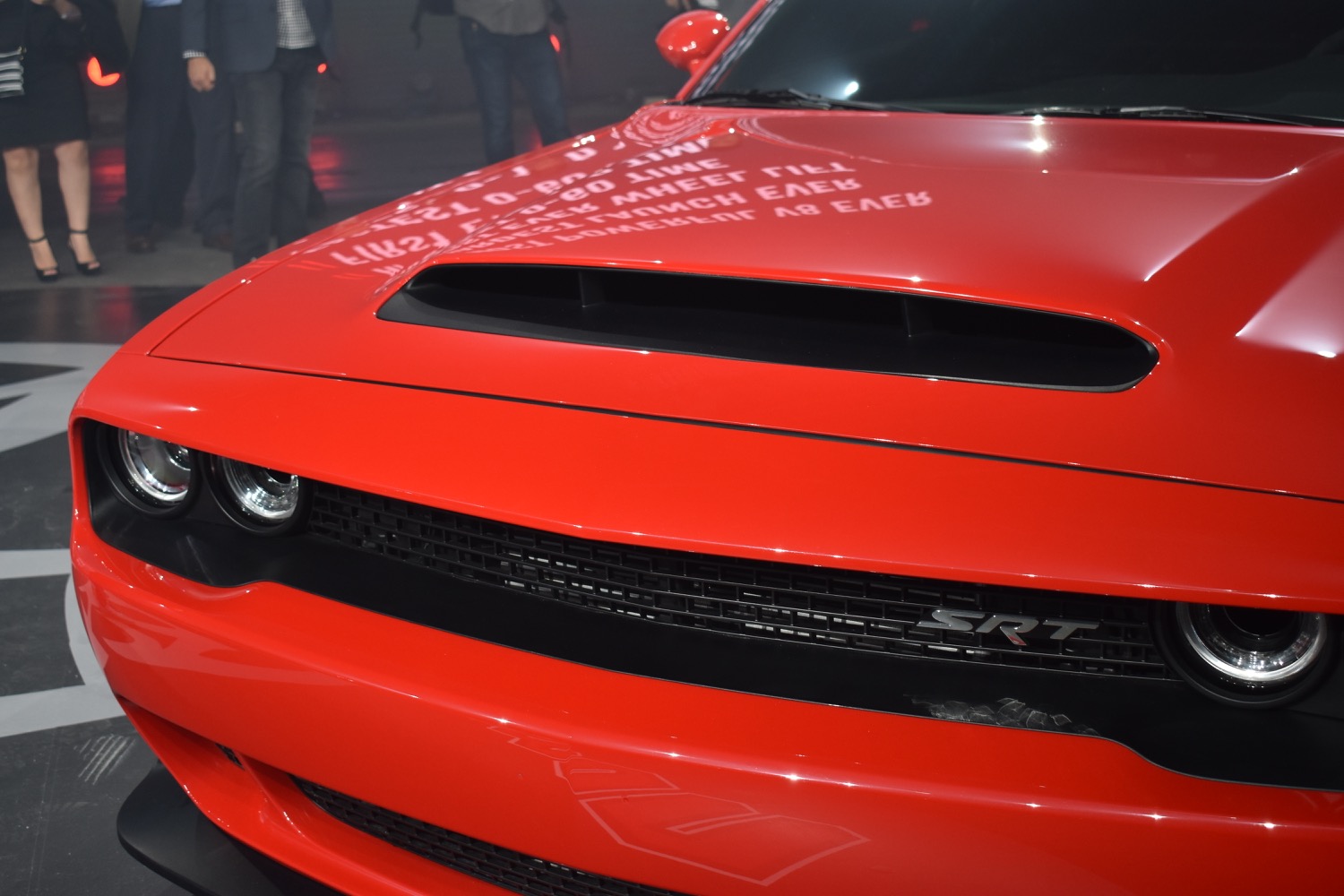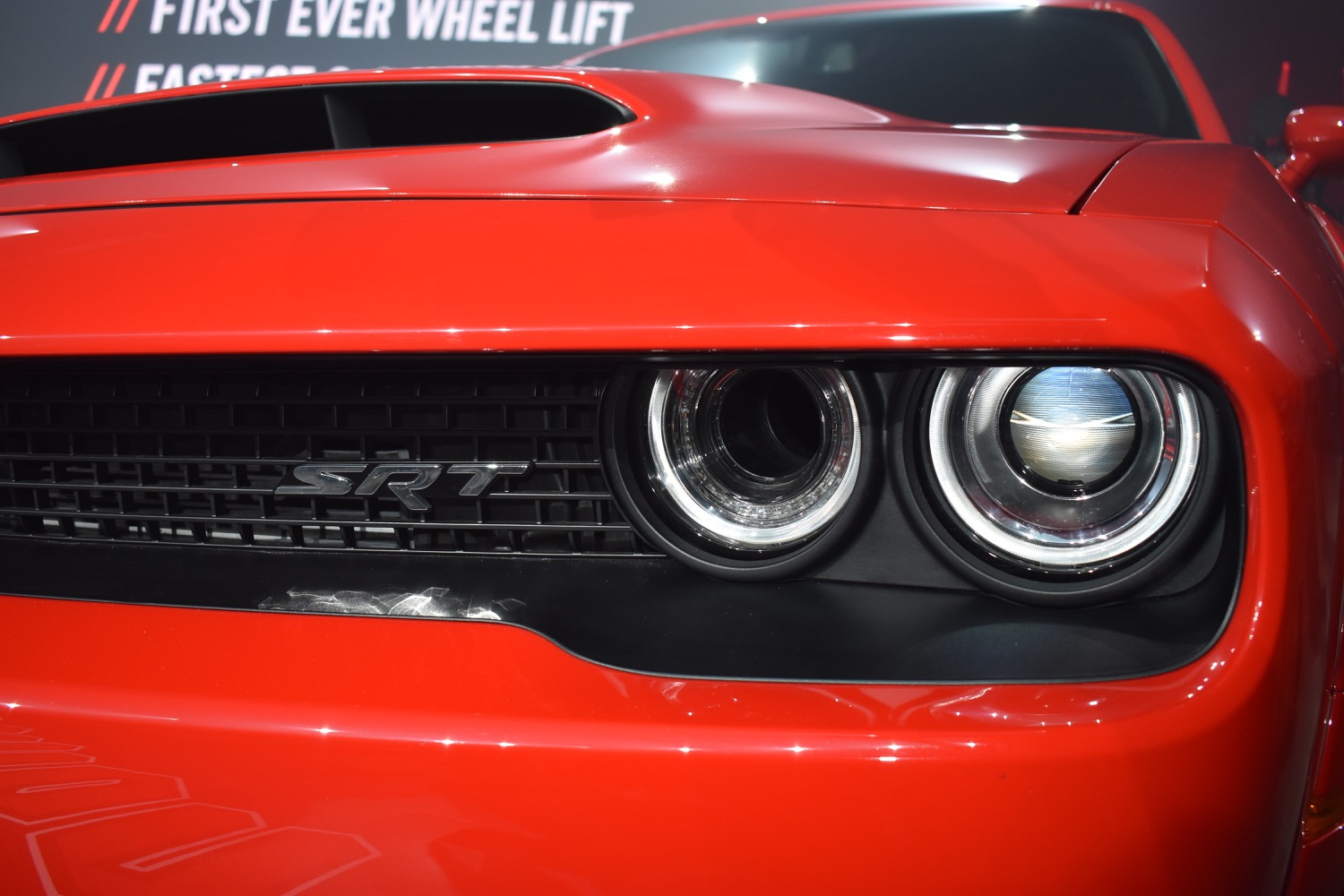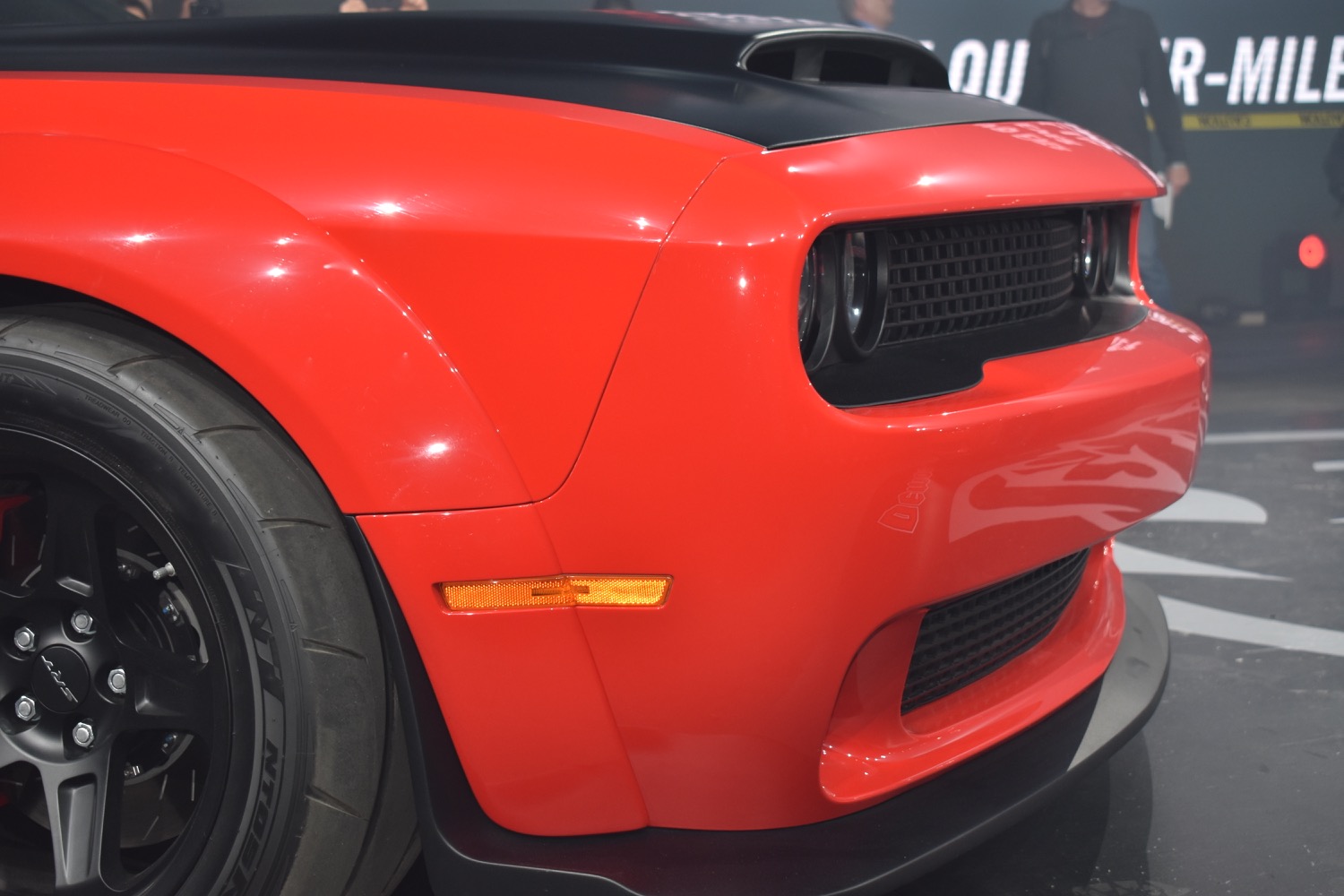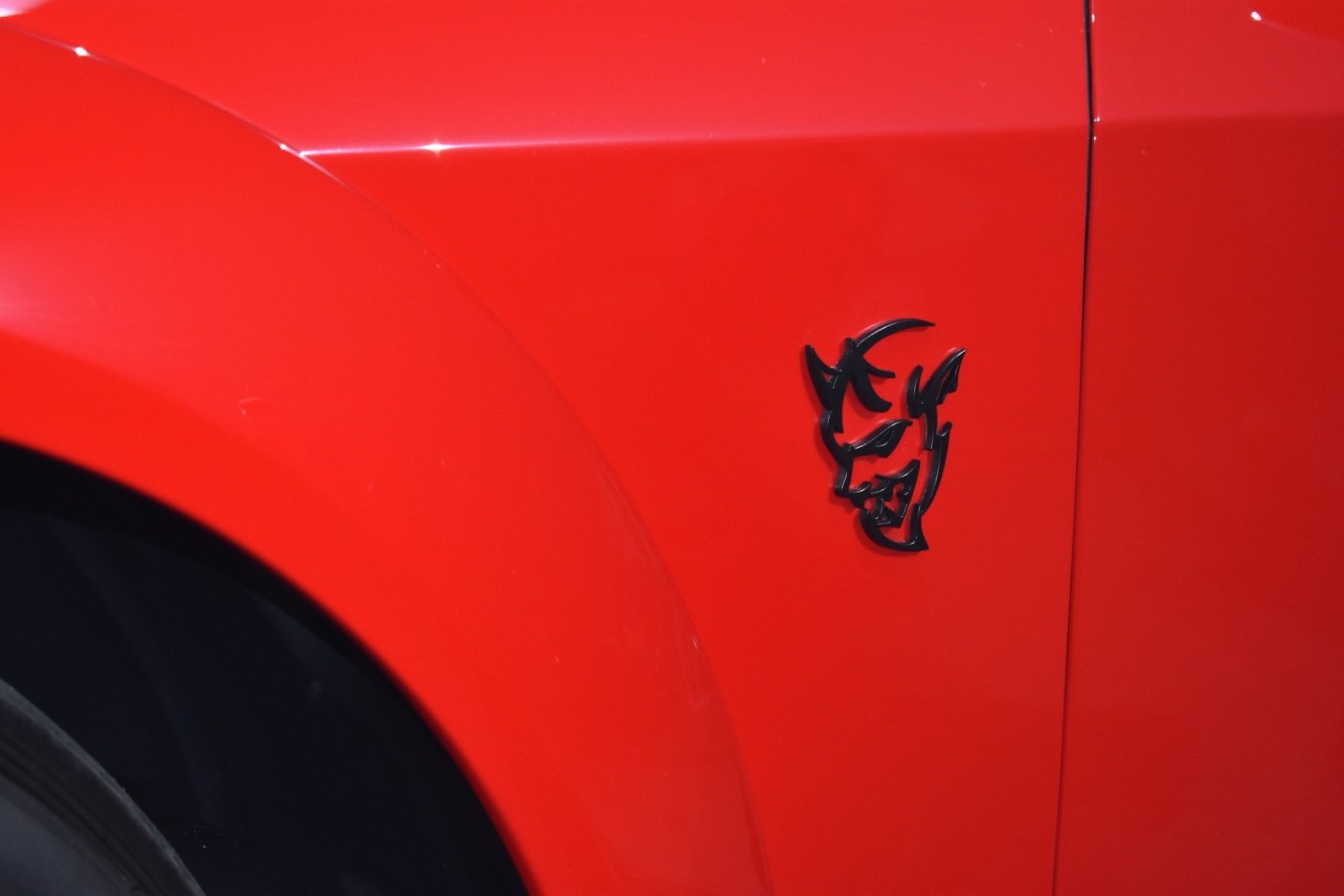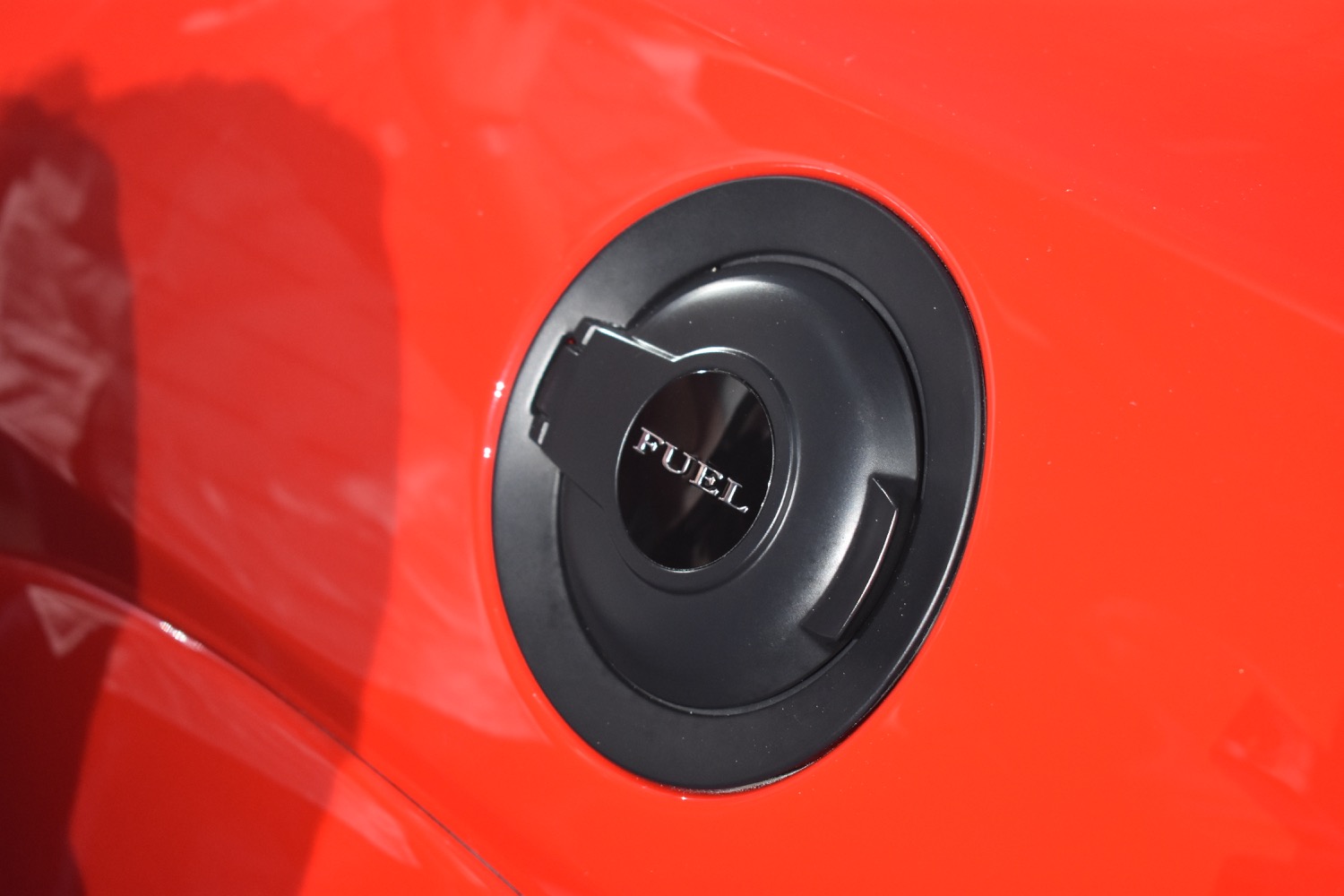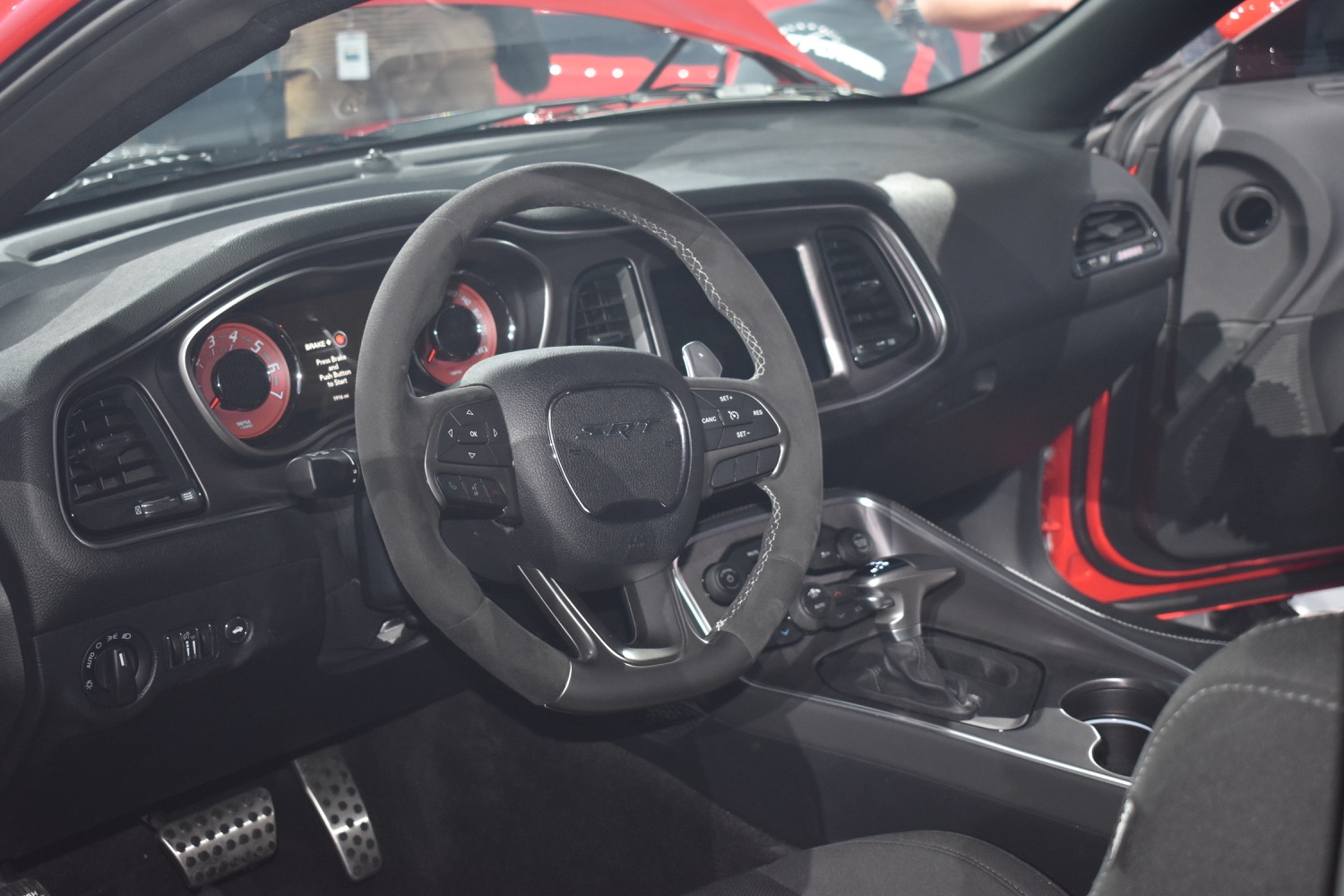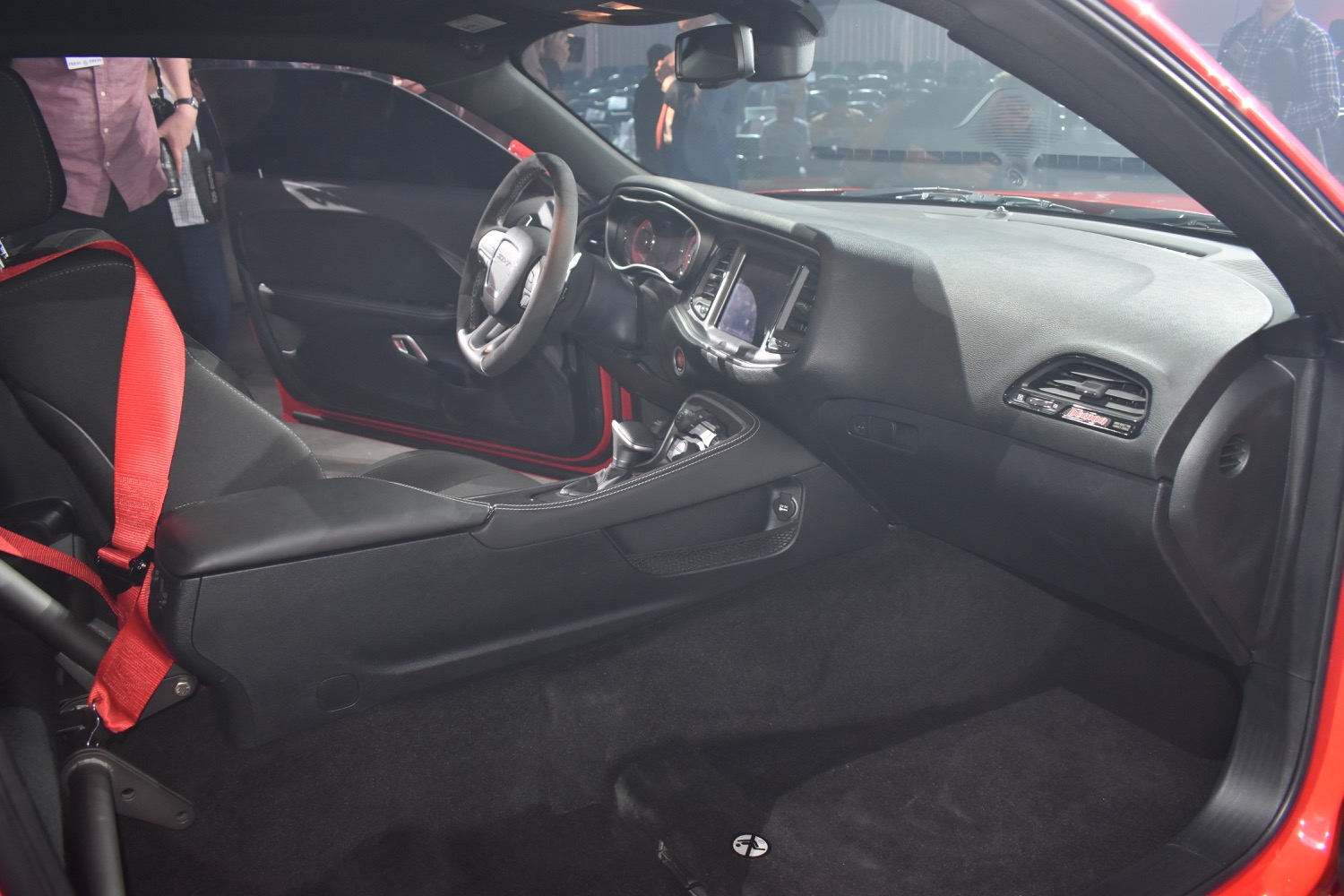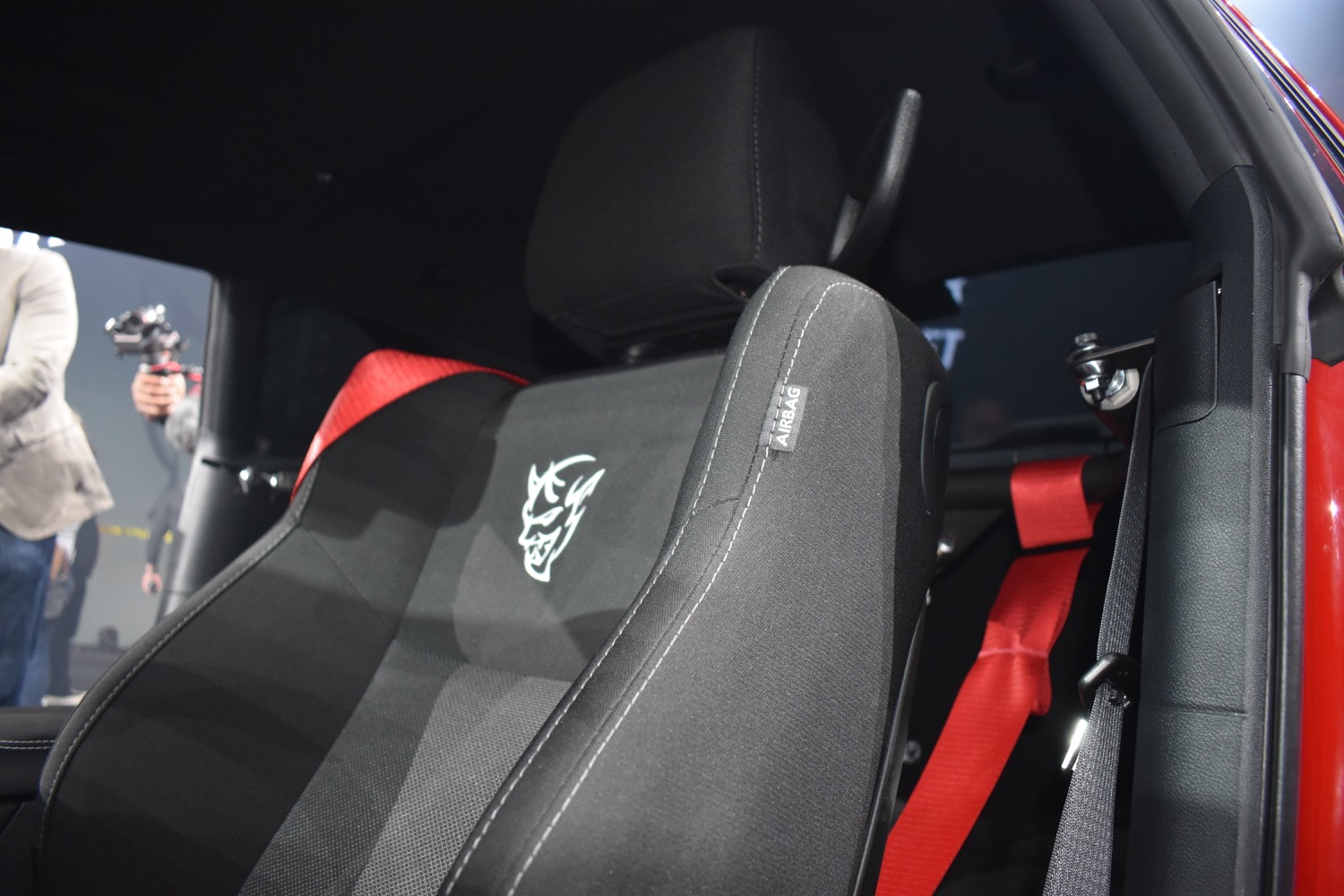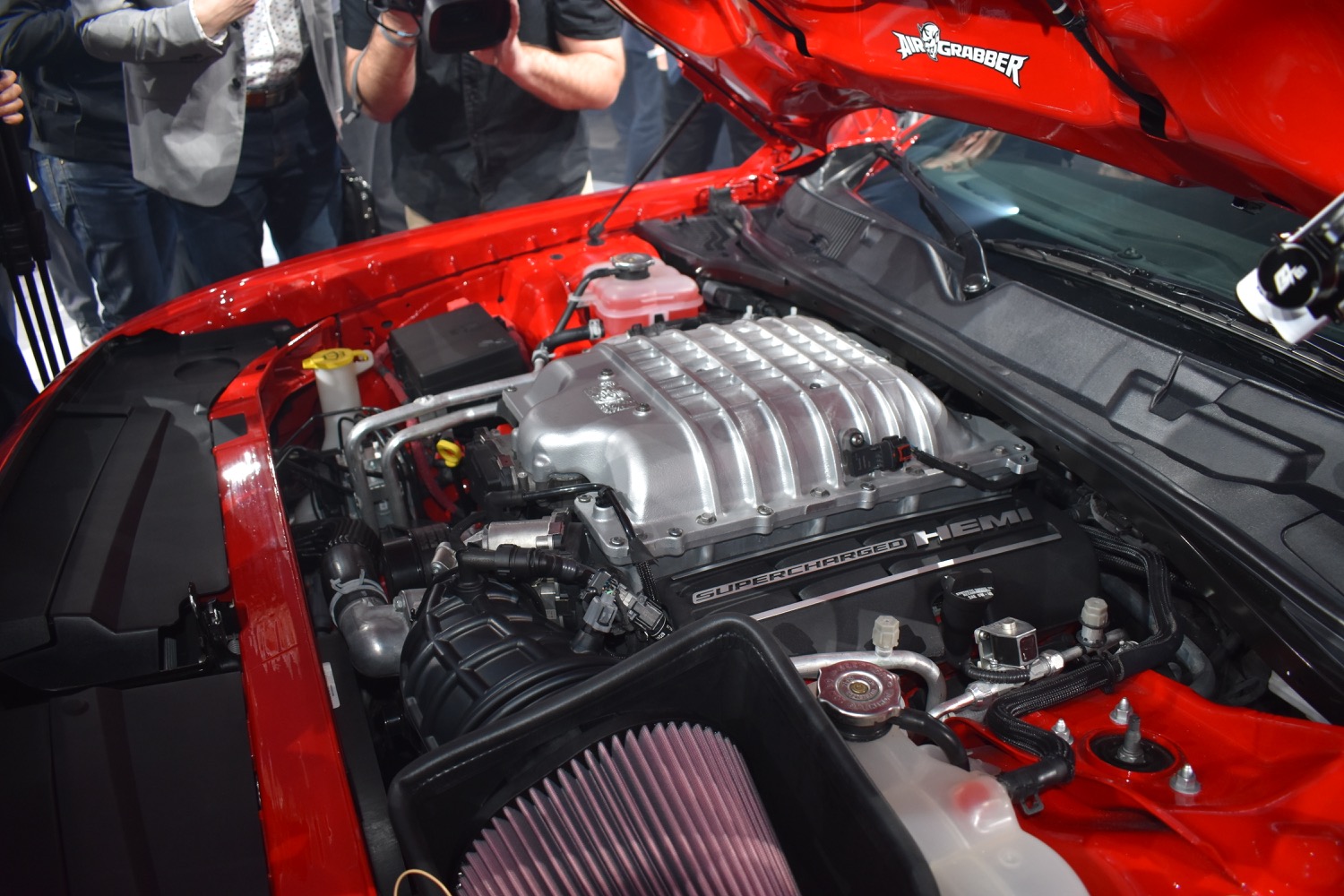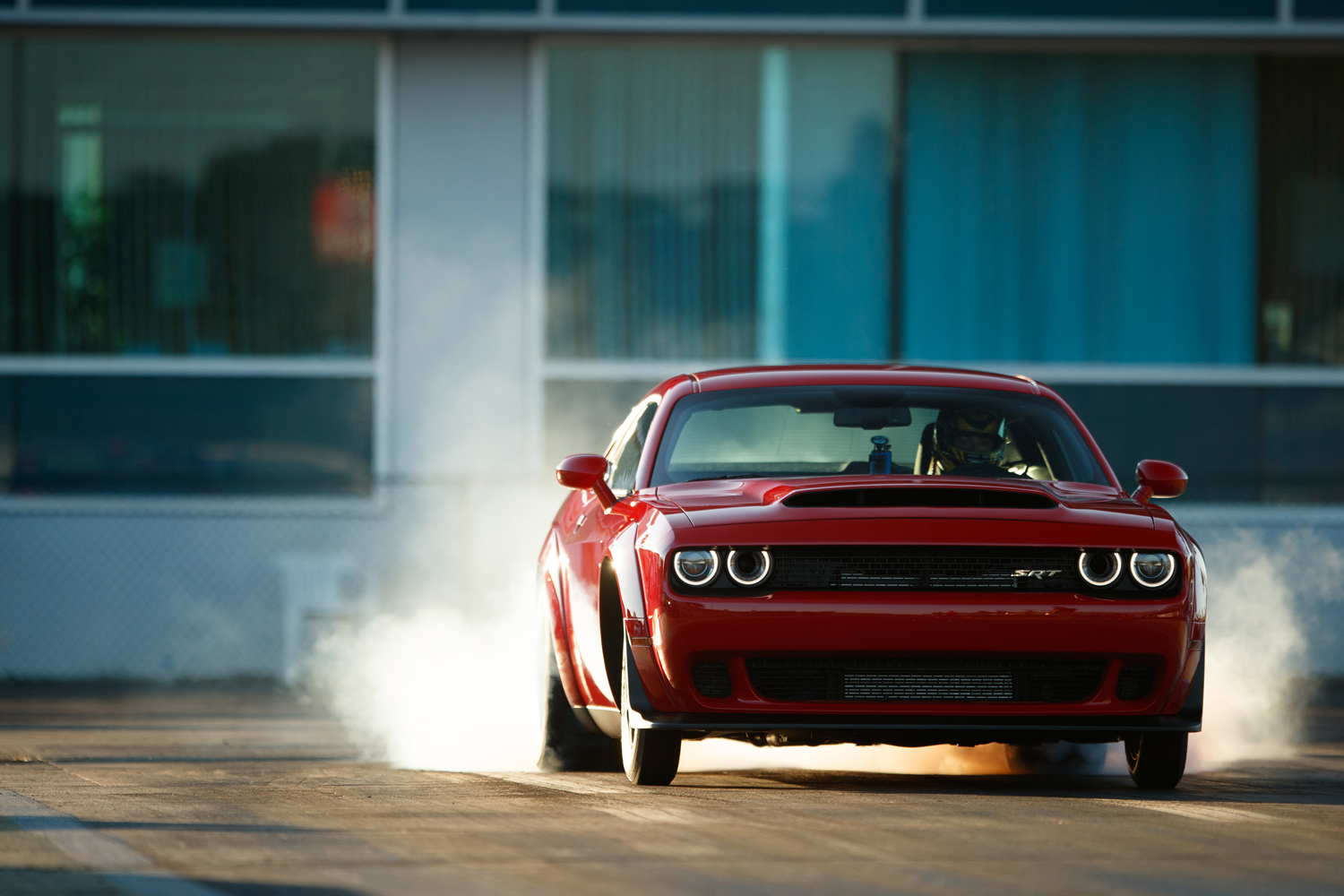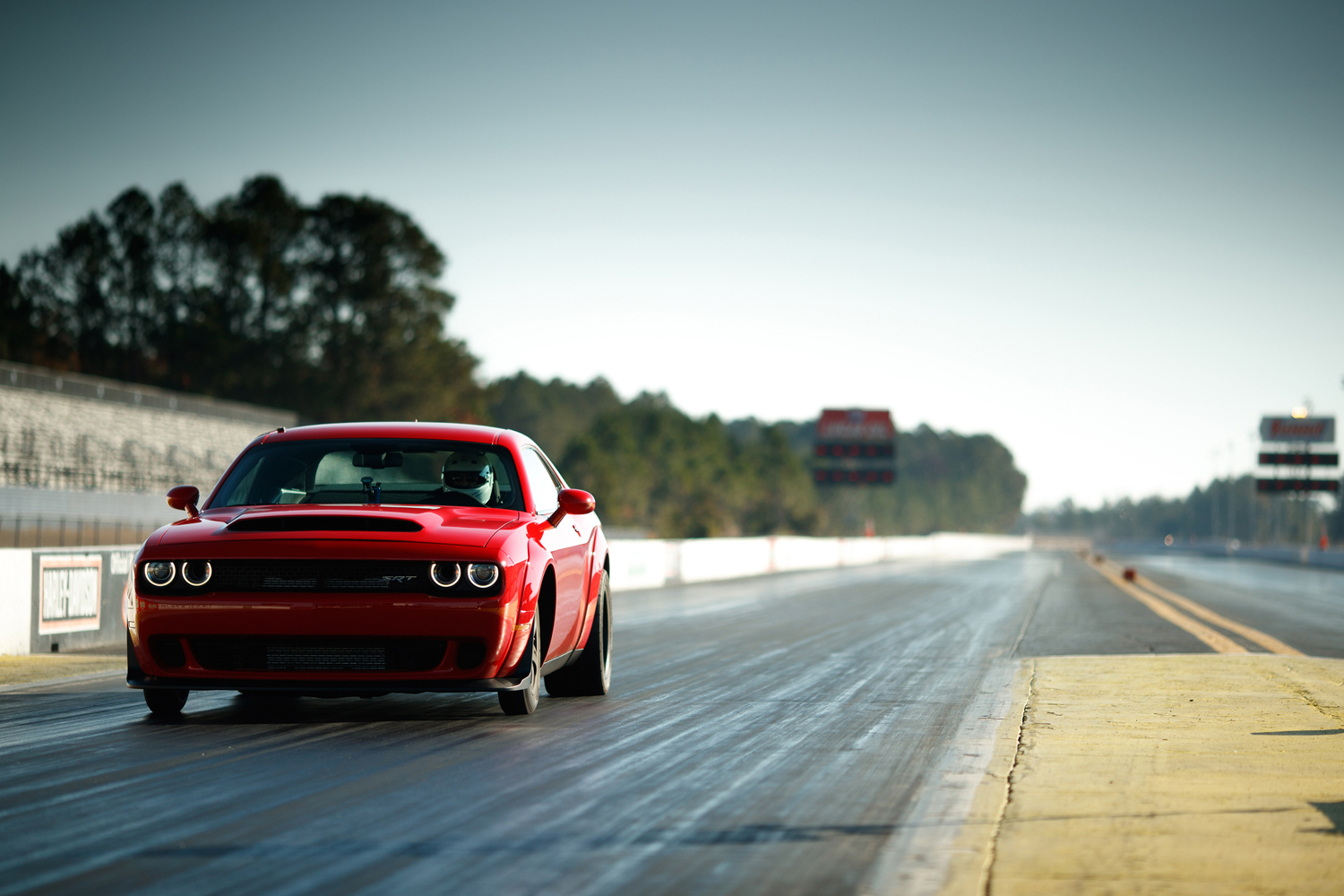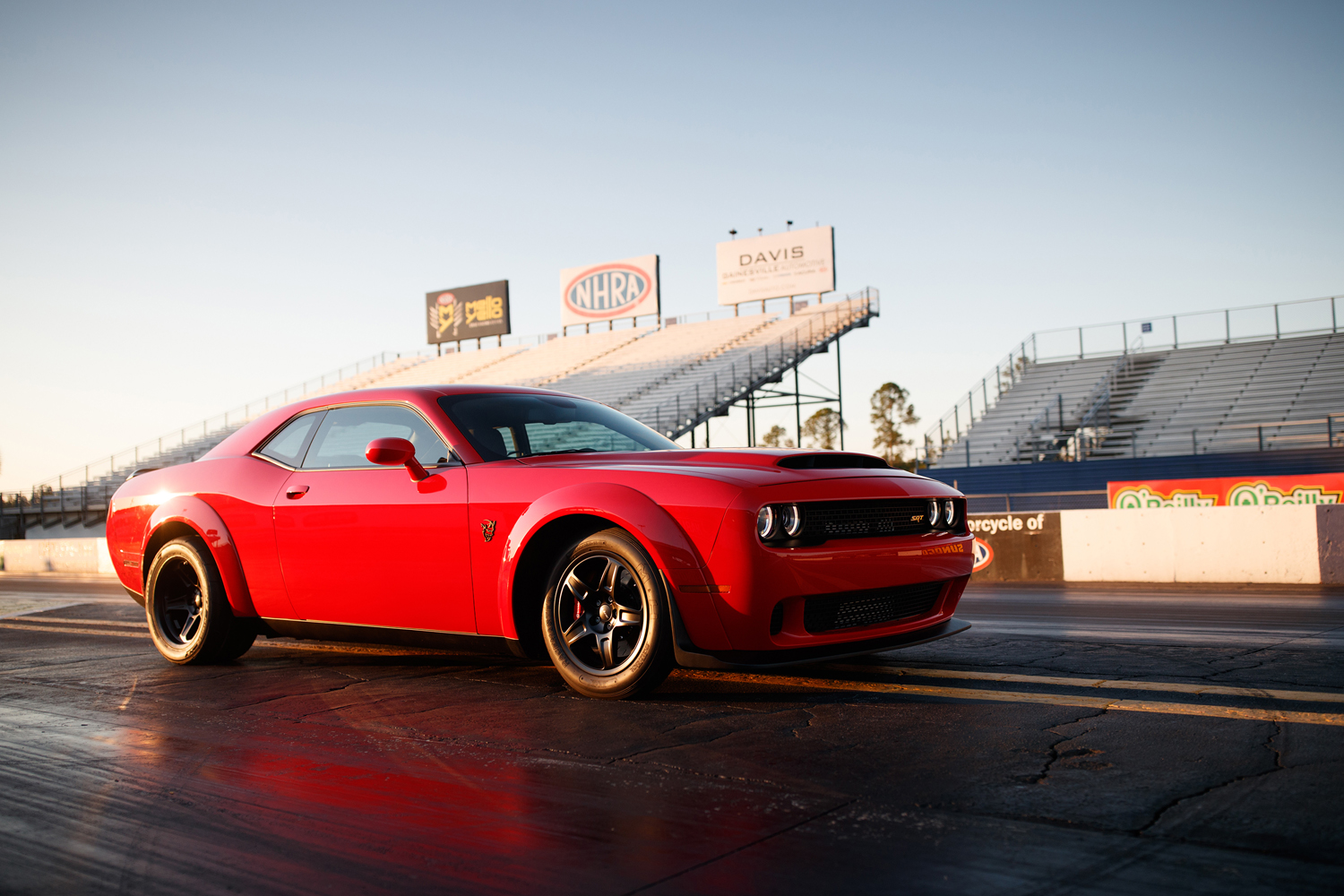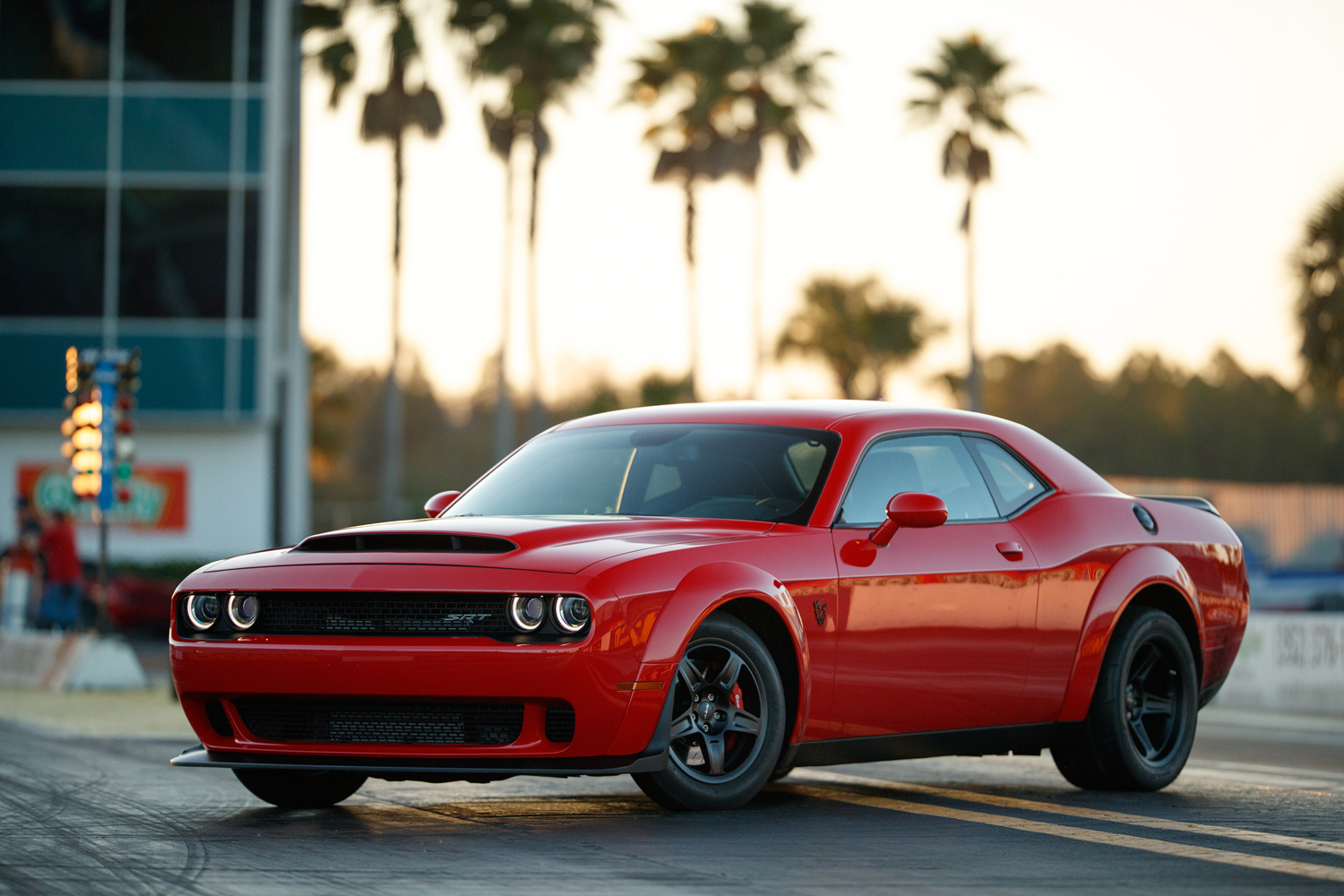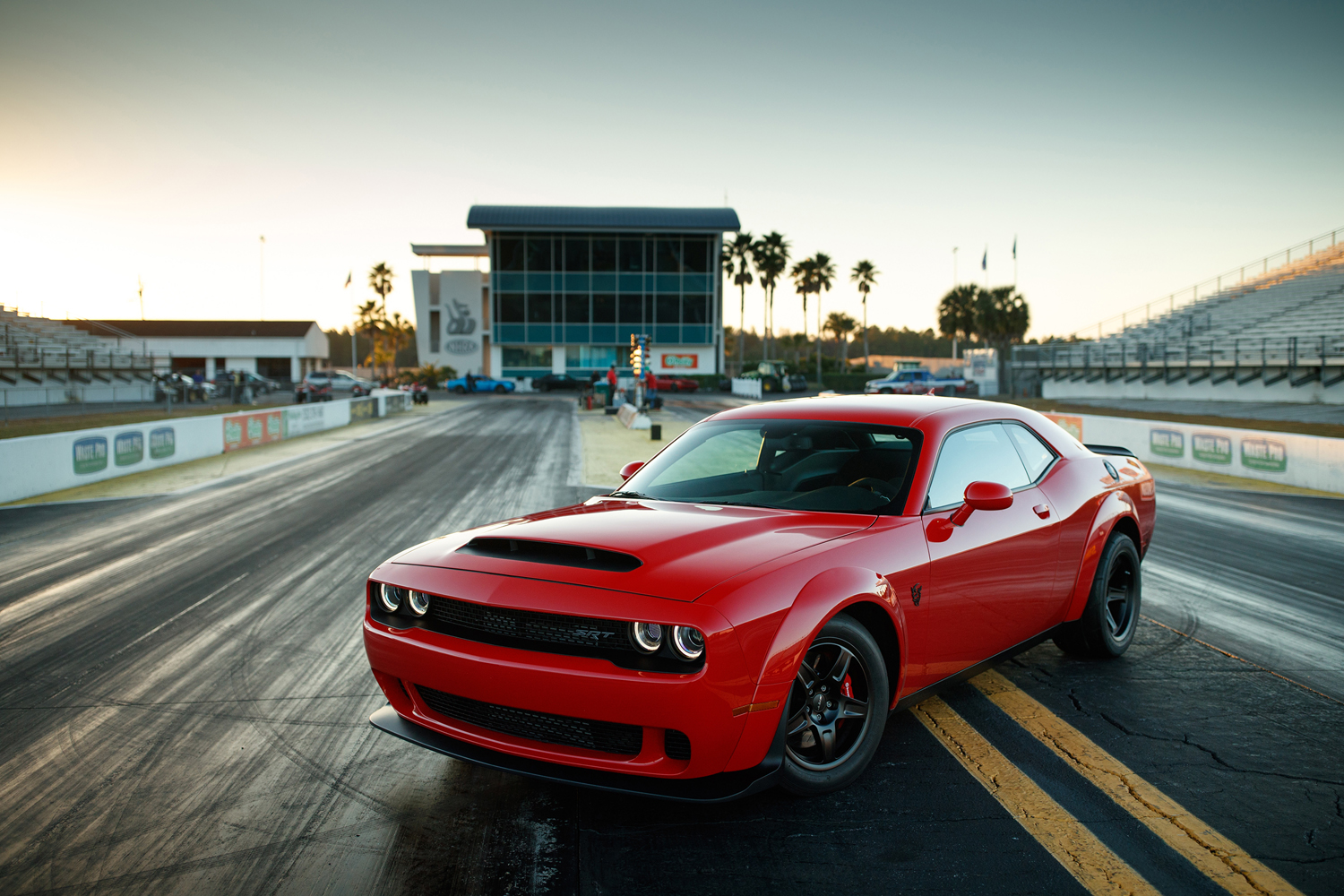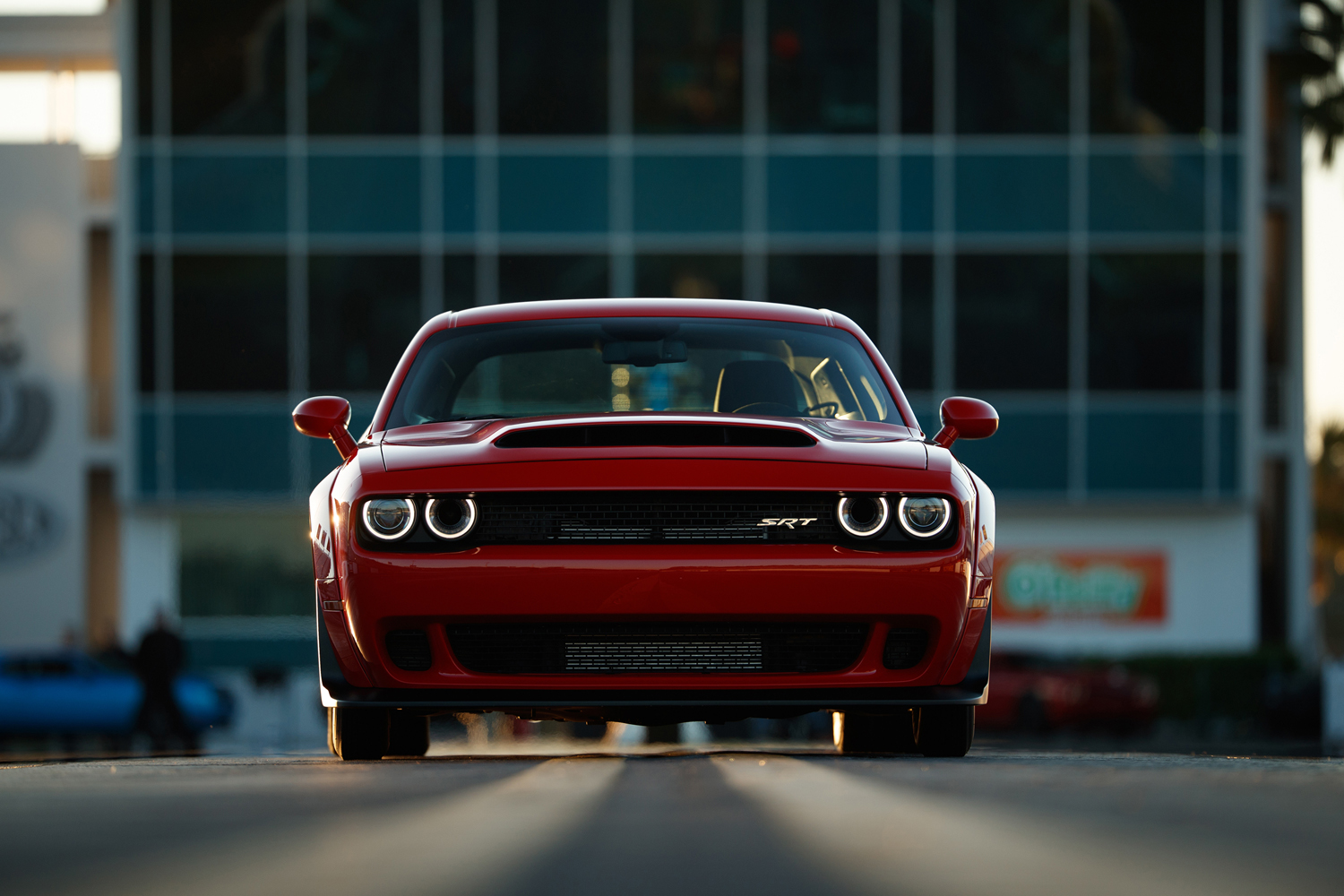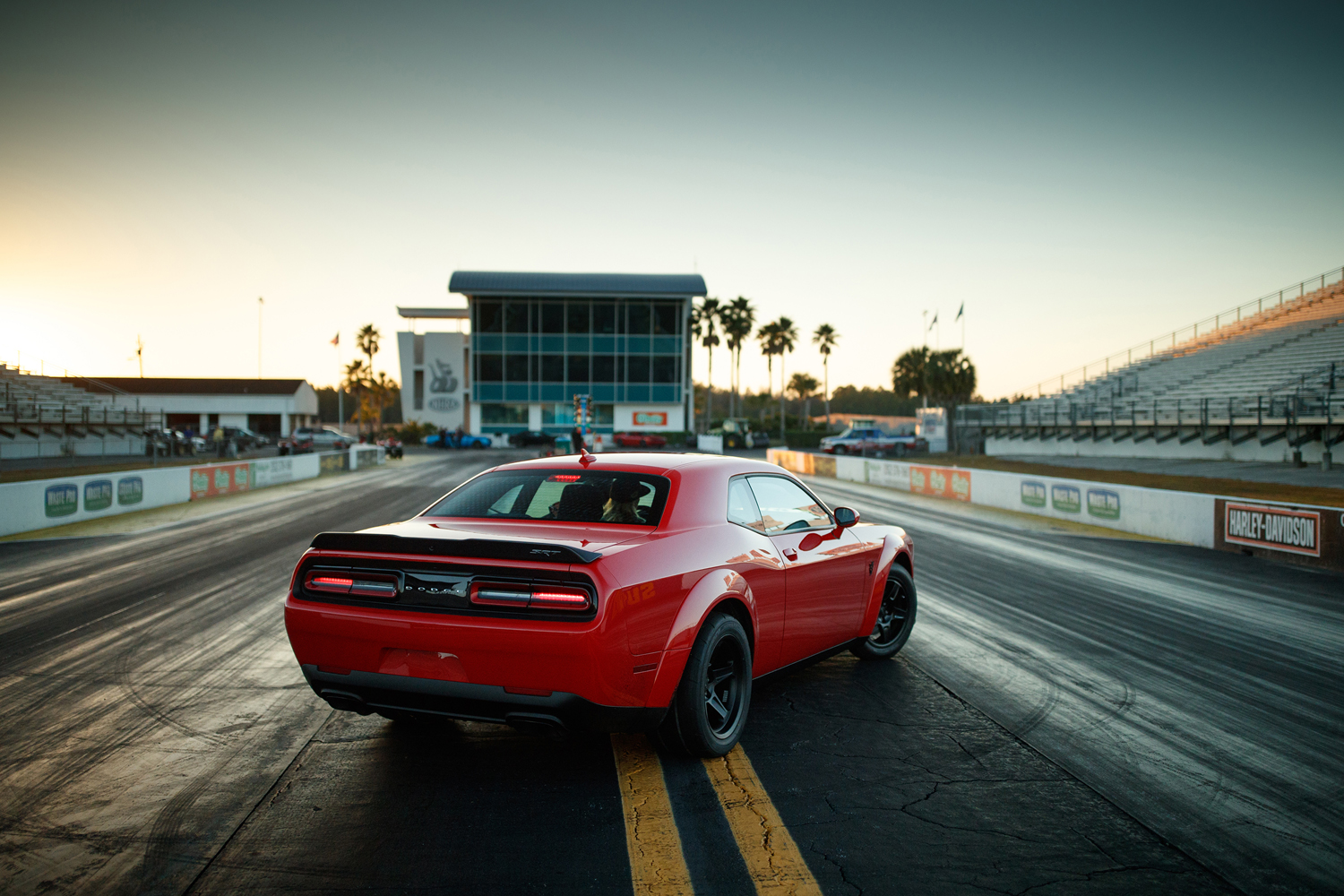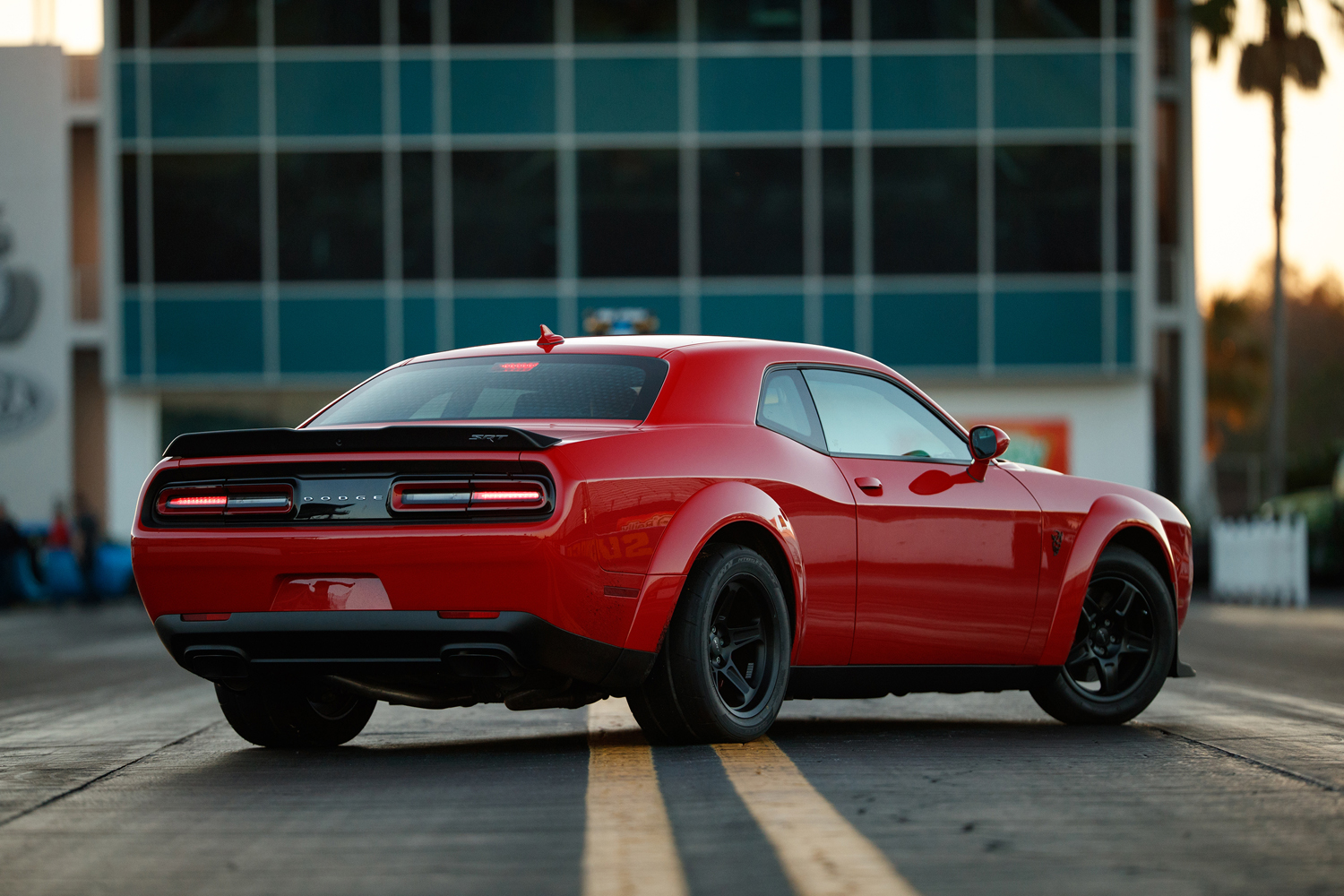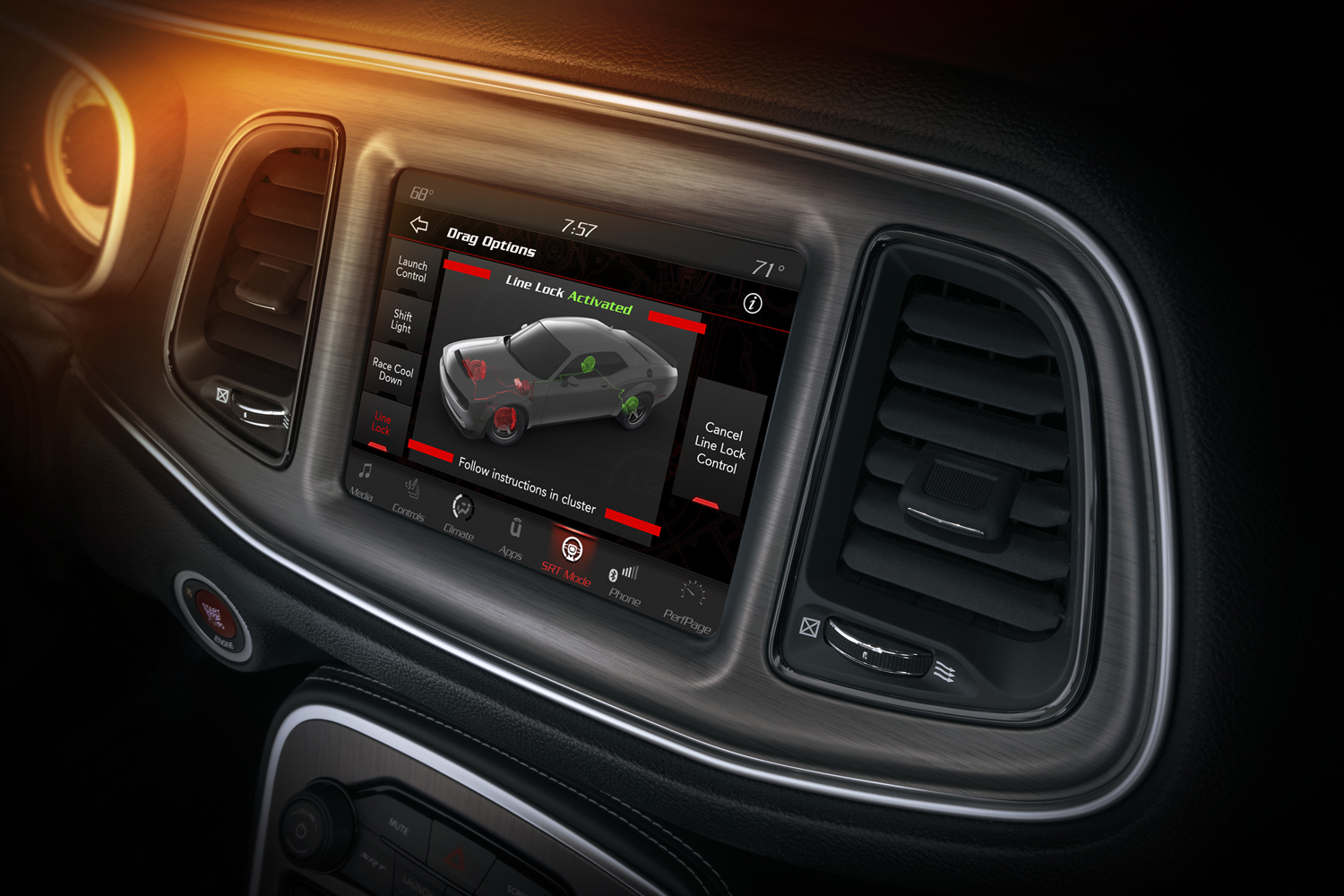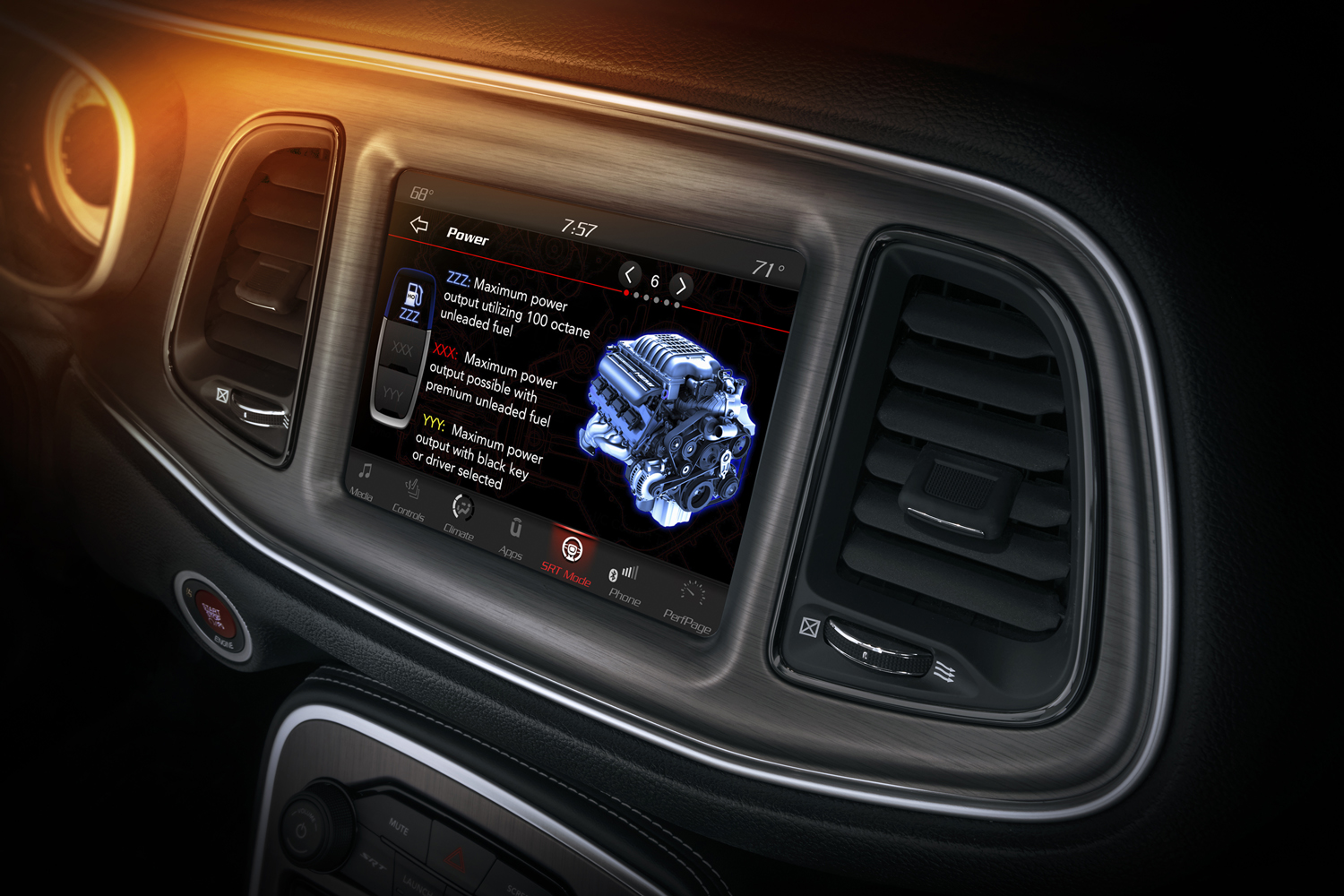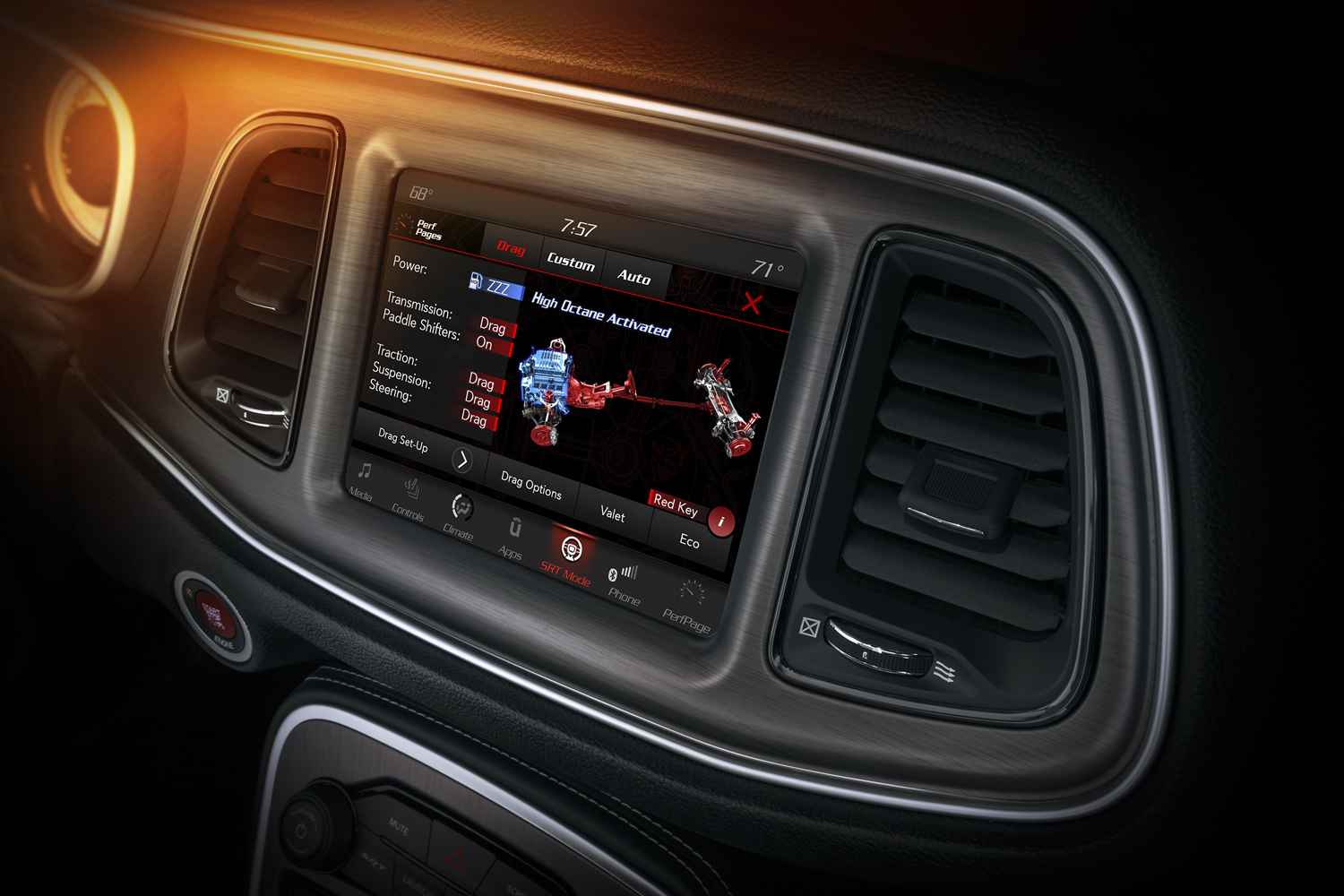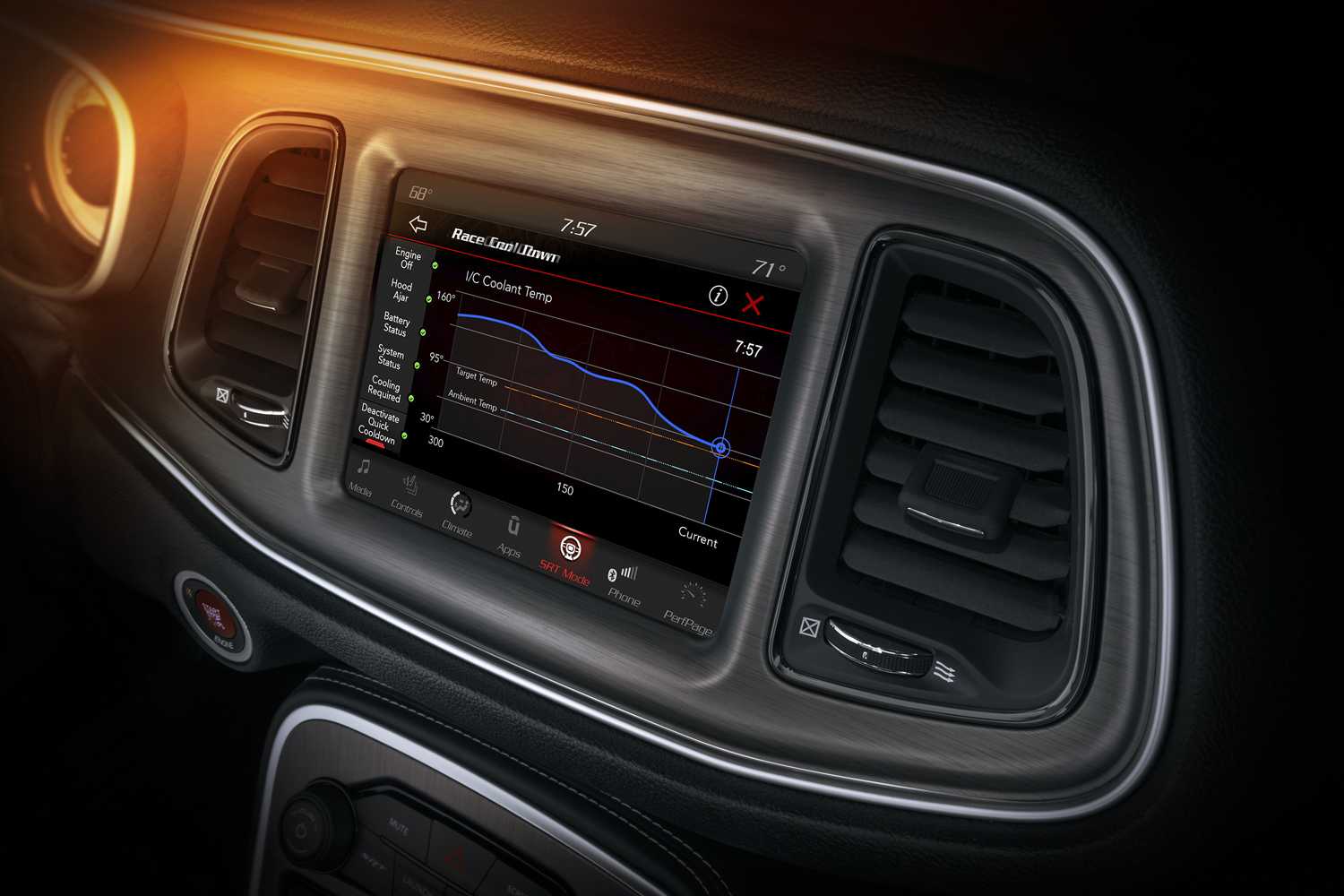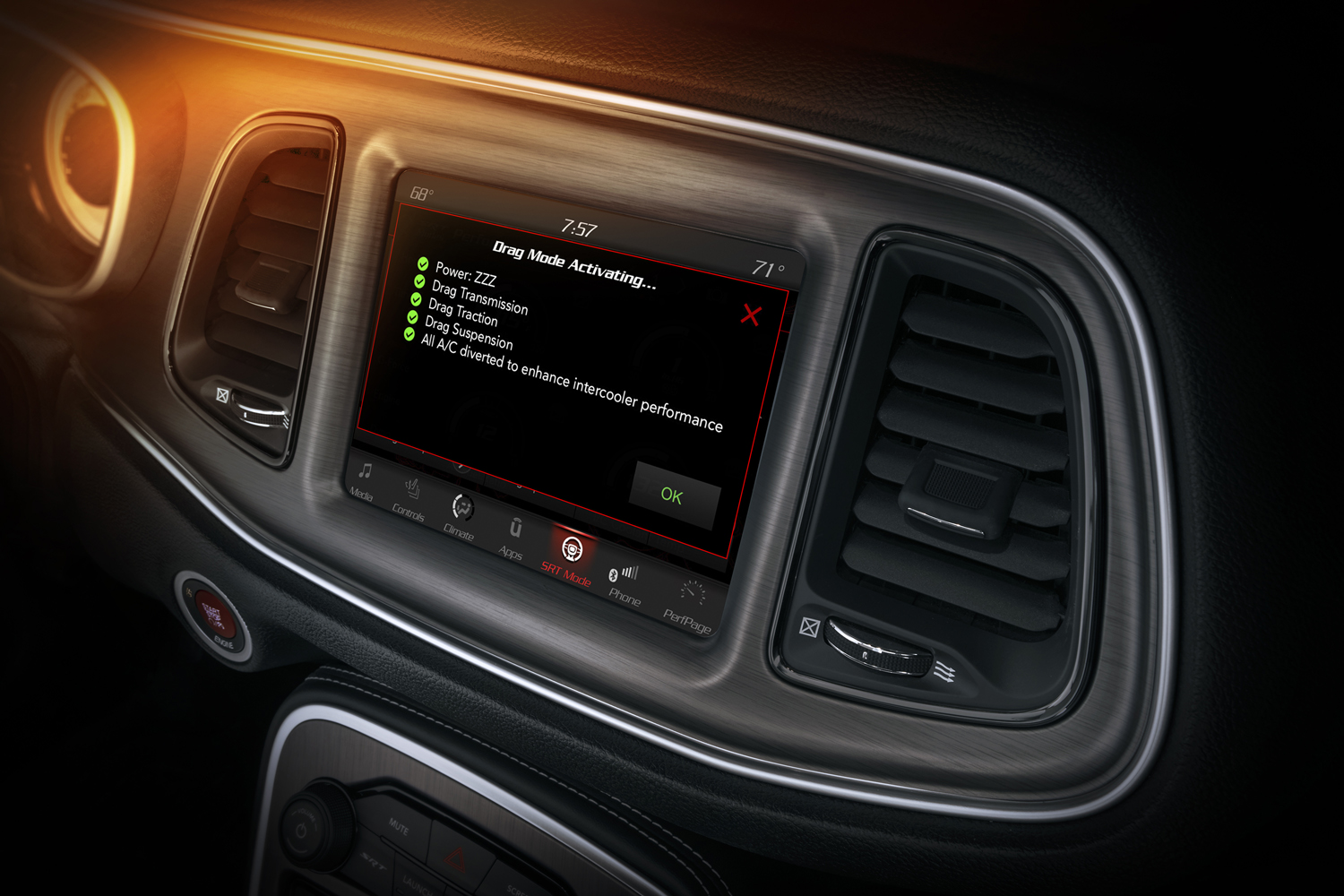There’s a new version of the Dodge Challenger Demon muscle car that’s even more extreme than the vaunted Hellcat. The aptly named Challenger SRT Demon is the company’s latest hot rod, and it broke cover at a private event ahead of the New York Auto Show after a teaser campaign that lasted a whopping 13 weeks. That was the first record the Demon collected, but it certainly wasn’t the last.
The beast is unleashed
The first production 2018 Dodge Challenger SRT Demon just rolled off the assembly line this past week, a spokesperson for FCA told MotorAuthority. The color and build are unknown, but we can probably eliminate Indigo Blue, B5 Blue, and classic Plum Crazy, as these paints are listed as “Late Availability” on the Demon’s build page.
FCA also said that customer deliveries will take place “following containment at the plant.” We’re not sure what that means, but that’s likely intentional.
Prepare for takeoff
Ahead of the Demon’s debut, Dodge ambitiously promised it would raise the bar in terms of power and speed, and we’re glad to report it kept its word. Between the front fenders lies an evolution of the Challenger Hellcat’s supercharged 6.2-liter V8 engine tuned to generate 840 horsepower and 770 pound-feet of torque when it’s burning 100 octane fuel, figures that make it the most powerful factory-built eight-cylinder engine in the industry. Even big names like Mercedes-AMG can’t beat it.
The eight-cylinder spins the rear wheels via an eight-speed automatic transmission that can be left in drive or shifted manually using paddles mounted behind the steering wheel. The Demon rockets to 60 mph in just 2.3 seconds and blasts through the quarter-mile in 9.65 seconds at 140 mph. In fact, it’s so fast that it’s banned from the drag strip by the National Hot Rod Association (NHRA), according to Dodge. Here’s hoping you have a private runway in your backyard.
A new feature named TransBrake locks up the transmission’s output shaft to keep the Demon stationary as the engine revs, allowing for brake-free launches at up to 2,350 rpm. This technology is commonly found in dragsters, but it has never been offered in a factory-built car before. When TransBrake is engaged, all the driver has to do to pelt the muscle car down a drag strip is flick one of the steering wheel-mounted shift paddles.
From a standing start, Dodge’s hottest muscle car can pop a wheelie for 2.92 feet, a Guinness-certified record for a production vehicle. And while accelerating on two wheels sounds like it’s frowned upon by the National Highway Traffic Safety Administration (NHTSA), the Demon is fully street-legal across the nation.
Feeding the beast
The Demon runs on 91-octane premium fuel in regular driving conditions, which limits the car’s output to 808 hp and 717 lb-ft. Trust us, that’s plenty. But if you need that extra grunt, the Demon’s V8 can be configured to slurp 100-octane gasoline (and higher) for the full output of 840 hp and 770 lb-ft. Your friendly neighborhood Chevron probably doesn’t carry high-octane fuel, but it’s available at select gas stations, specialty shops, and drag strips.
Feeding the V8 high-octane fuel does require swapping out the powertrain control module (PCM), a part best described as the engine’s brain. Owners also need to install a cluster of switches on the center console that include a button labeled “high octane.” Both parts are included in the optional Demon crate.
Mixing race gas and regular premium unleaded won’t damage the V8, but the high-octane mode won’t engage if sensors detect the combined fuel octane is too low. Regardless of what’s in the tank, dual fuel pumps and larger fuel injectors ensure the engine never goes thirsty.
Under the sheet metal
Dodge has upgraded the steering system and fitted bigger Brembo brakes on both axles to keep the V8’s prodigious power in check. The Demon also receives a set of extra-wide 18-inch wheels wrapped by Nitto tires that blur the line between street-legal and drag-racing rubber. More width equals more grip, and the setup is so wide that Dodge had to give the Demon massive fender flares.
It also gets a Drag Mode that optimizes performance for drag strip use, and an all-new suspension system with Blistein shocks that maximize weight transfer, traction, and control. The springs are softer than the Hellcat’s, and the sway bars are lighter.
The Demon weighs about 215 pounds less than its 707-horsepower counterpart, which is quite portly at about 4,500 lbs. No high-tech wizardry or advanced lightweight materials were involved in making the Challenger lighter. Dodge simply removed the passenger seat and all associated hardware, the rear bench, the parking sensors, the 16-speaker sound system, and most of the sound-deadening material, among other components deemed superfluous. CNET’s Roadshow has learned a factory-developed roll cage won’t join the list of accessories.
Drag racers who want to share the Demon’s ass-hauling aptness with friends can add the missing seats for $1 each when they order the car. Additional options include creature comforts like a 19-speaker sound system, leather upholstery, and a power sunroof.
Design and tech
The next evolution of the Challenger screams power even when it’s standing still thanks to a specific hood with a wide, thin scoop, and the largest cold air intake ever fitted to a production vehicle. Named Air Grabber, it measures more than 45 square inches. The Demon also benefits from a comprehensive body kit that includes a splitter at the bottom of the front bumper and a spoiler mounted on the trunk lid. In short, this car is not for those looking to keep a low profile.
The Demon comes standard with Dodge’s well-regarded Uconnect infotainment system, which groups the car’s navigation, connectivity, and entertainment functions into a single easy-to-use unit. A model-specific menu named Performance Pages provides real-time data such as how much power the engine is generating, the temperature of the supercharger’s intercooler, and g-forces, as well as vital information such as the oil pressure and the coolant temperature.
Dodge promises the Demon is the first car fitted from the factory with a liquid-to-air charge air cooling system. In simpler terms, some of the cold air that comes out of the air conditioning system gets routed to the unit that cools the air as it enters the supercharger. The system lowers the temperature of the air used for the combustion process by up to 45 degrees, resulting in improved performance.
The Demon also receives an after-run chiller. Any engine gets exceptionally hot after high-speed jaunts, so the driver can program the cooling fan and the intercooler to run even when the ignition is turned off until the V8 reaches a pre-set temperature. This system ensures the engine lasts longer by putting less wear on mechanical components.
From the road to the track
Designed for the mechanically inclined, the Demon is available with a crate full of Snap-On tools and parts so that owners can go from a street- to a track-oriented setup by turning a few wrenches. The optional box is filled with eighteen components including Demon-branded tools (a hydraulic floor jack, a torque wrench, and a cordless impact wrench), narrow front runner wheels for track use, performance parts, and the aforementioned high-octane PCM.
The Dodge Challenger Demon will be branded a 2018 model when it arrives in showrooms this fall. Act fast if you want one, because Dodge will only build 3,000 examples for the United States and 300 more for Canada.
Pricing starts at $86,090, according to Dodge, a figure that includes a $1,700 gas-guzzler tax and a mandatory $1,095 destination charge. The list of options includes the Demon Crate, a passenger seat, a rear bench (upholstered in either cloth or leather), and a trunk carpet kit. The good news is that every option costs just $1. That’s right; unlocking the Demon’s full capacity costs less than a McChicken sandwich.
Dodge has a strategy to fight against dealers marking up the Demon well beyond its suggested MSRP. Autoblog reports cars purchased at or below MSRP will be built first, ensuring an earlier delivery. Dealers who choose to make more money on a sale will have to wait until the end of the production run to receive the car.
The fine print
As a street-legal dragster, the Demon is for the brave and the experienced. Dodge wants to make sure it doesn’t end up in the wrong hands by making buyers sign a release form, according to Jalopnik.
The three-page document puts a big focus on the Nitto NT05R tires, which were called out as unsafe and barely street-legal in a controversial opinion piece penned by industry trade journal Automotive News. Notably, they can’t be used in wet weather because they increase the risk of hydroplaning, they aren’t appropriate in temperatures below 15 degrees Fahrenheit, and they’re not for highway driving. Dodge emphasizes the tires should always be inspected for signs of cracking and damage.
That’s not all. As you’d expect, owners aren’t allowed to test the track-only features — like the high-octane mode — on public roads. A car shipped without a passenger seat or a rear bench can’t be turned into a five-seater later on for safety reasons. And, the document states that if you’ve only got one seat, your car is strictly a one-seater; carrying passengers is prohibited.
“Customer hereby assumes all risk associated with the vehicle and waives any and all claims against [the manufacturer] and/or dealer,” the last page of the document states. In other words, be warned: by buying a Demon, you waive away your right to sue if something goes horribly wrong on the road or on the track.
Update: Added information about the Dodge Demon’s first production car rolling off the assembly line.

